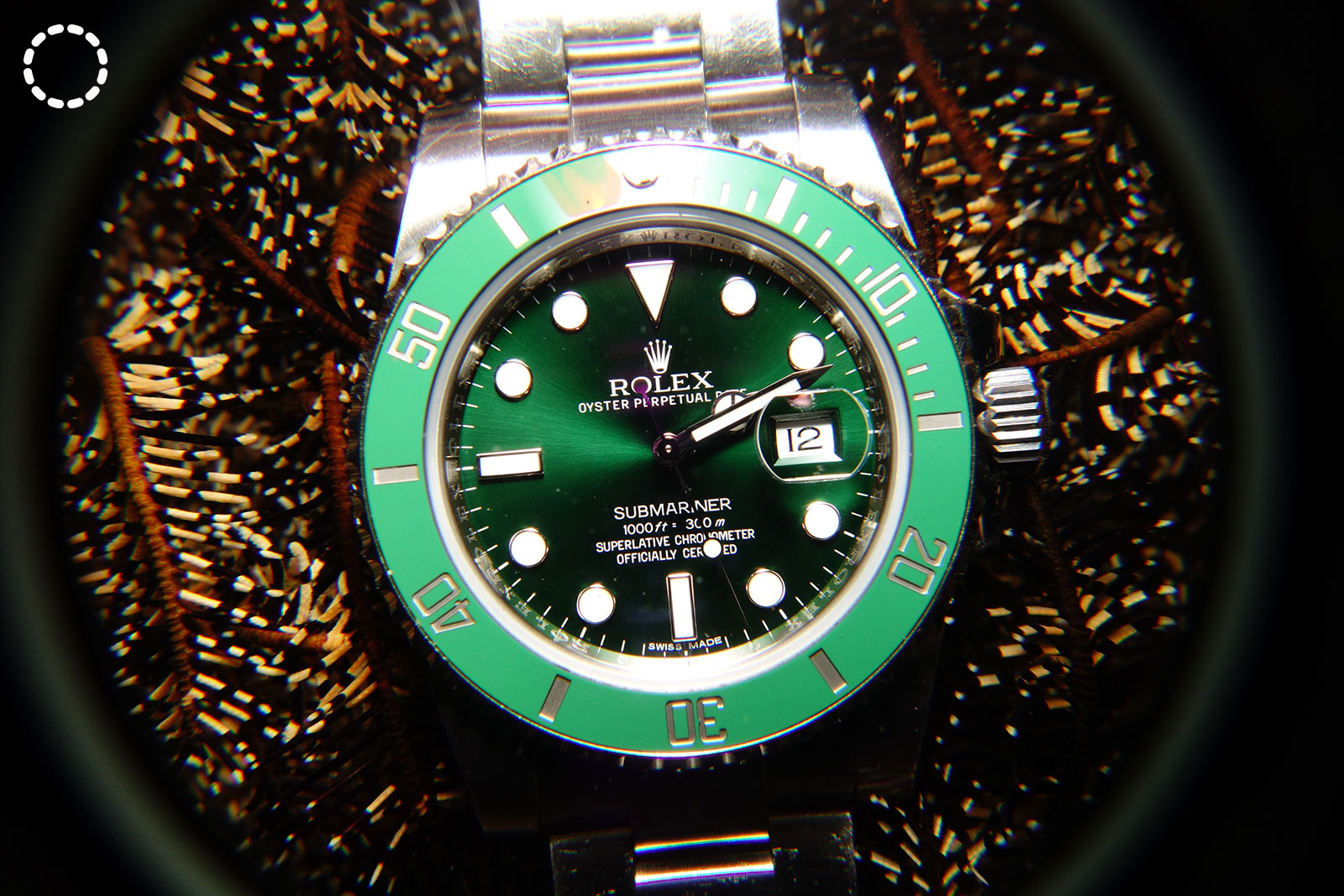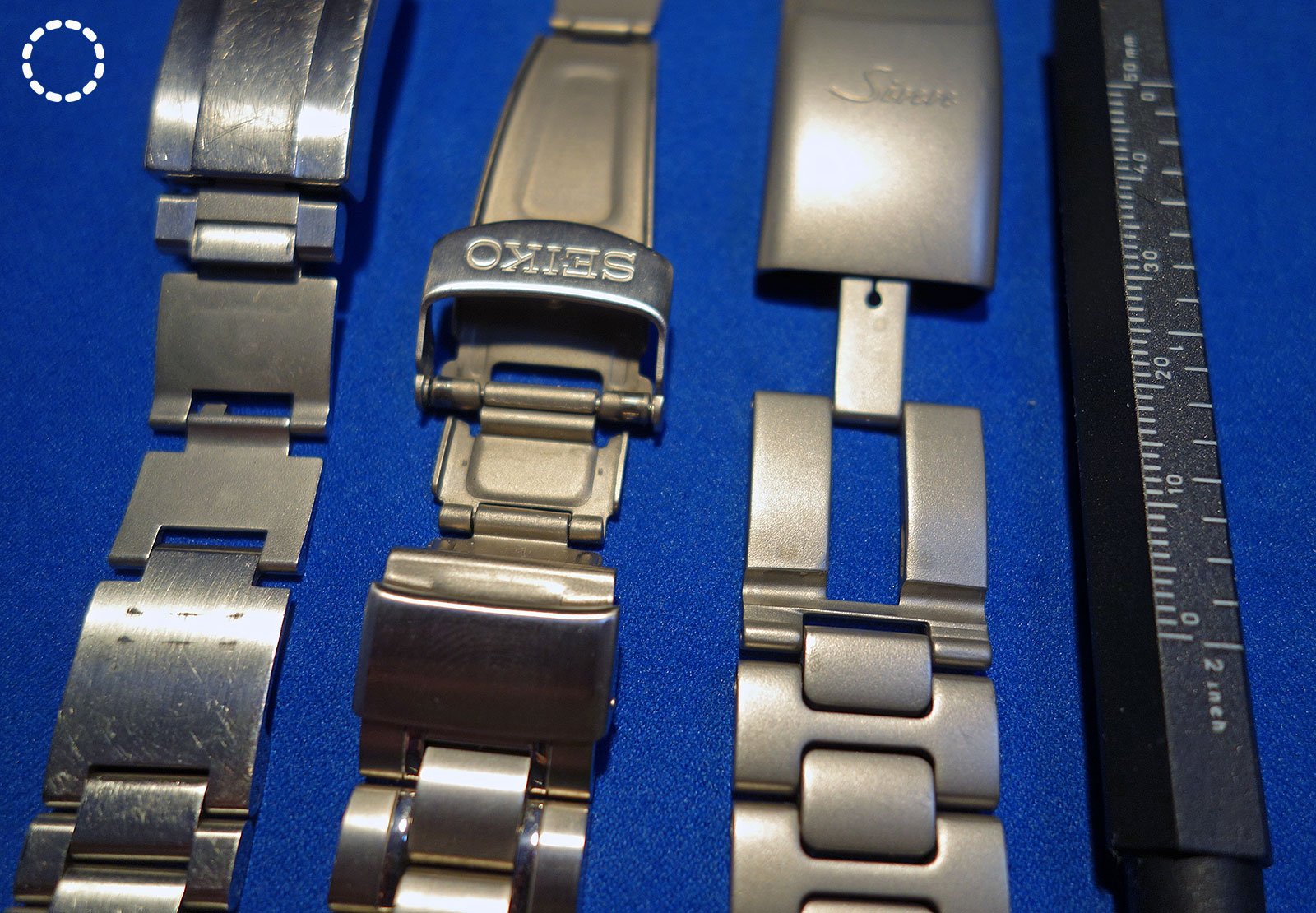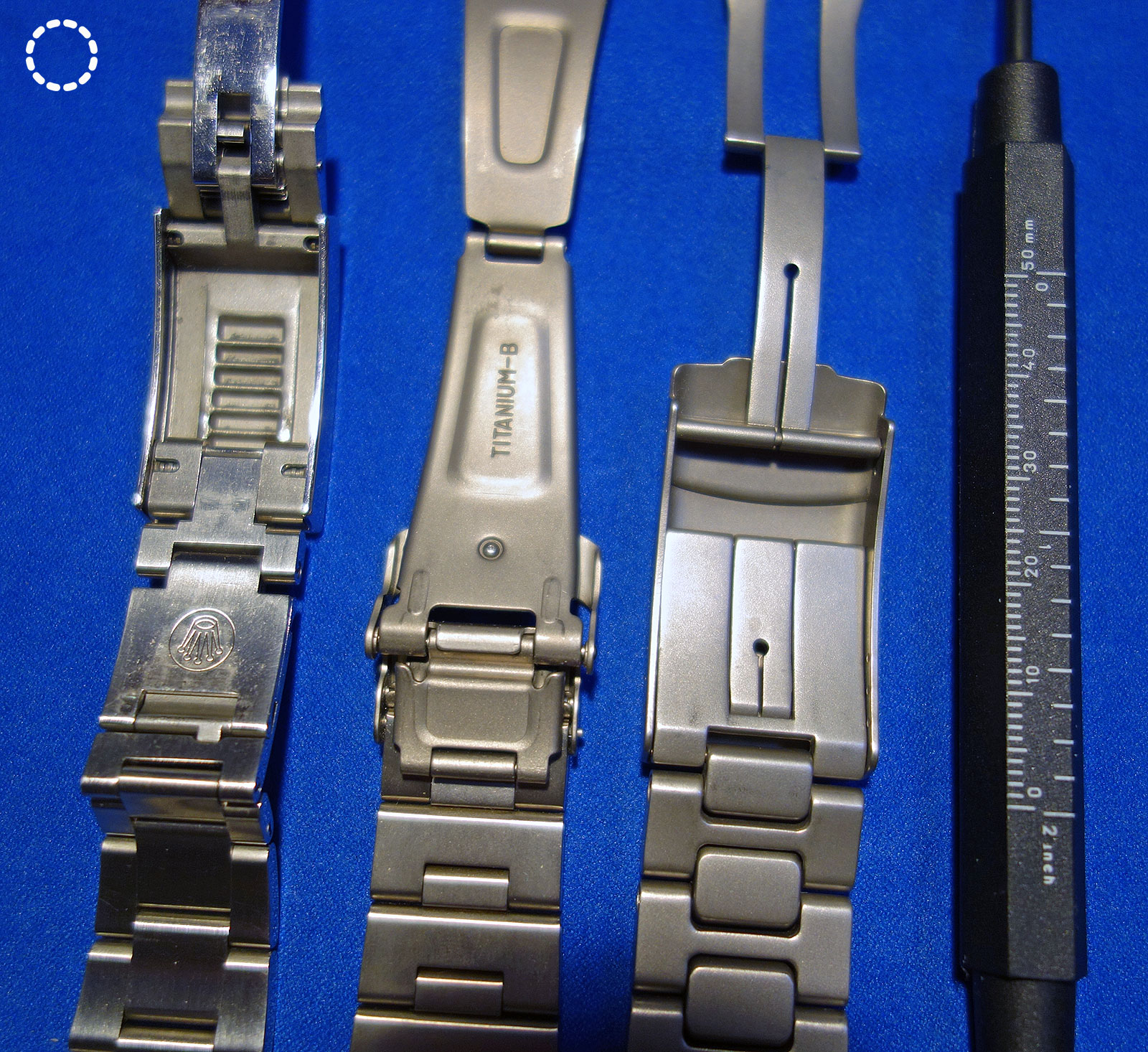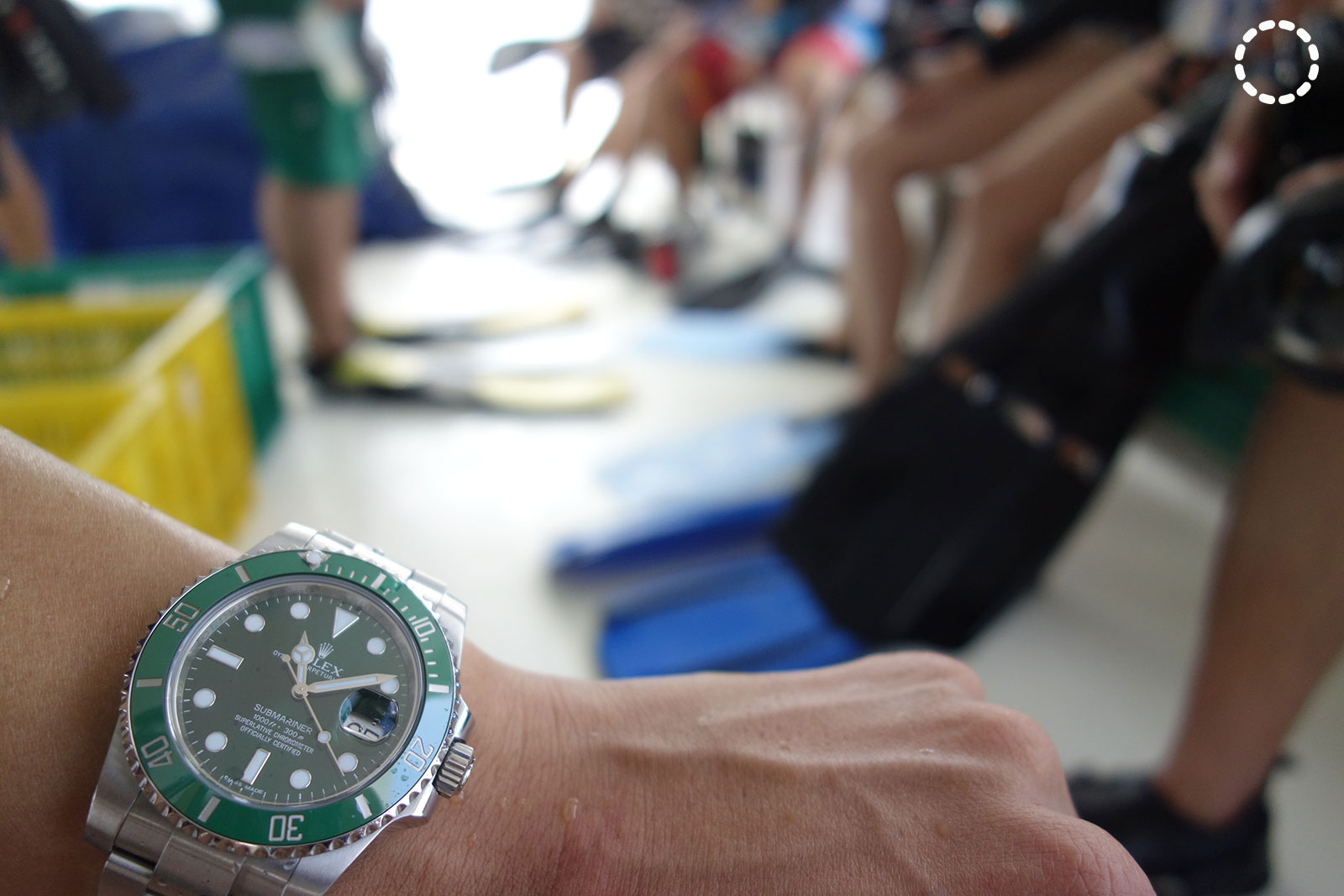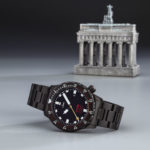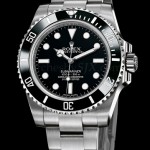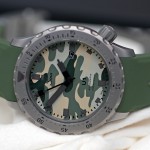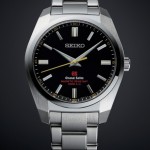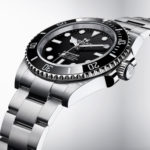Real World Test: Diving with the Rolex Submariner, Sinn U1, Seiko Turtle & Prospex PADI
A Master Scuba Diver puts a few of modern watchmaking's best known dive watches through their paces.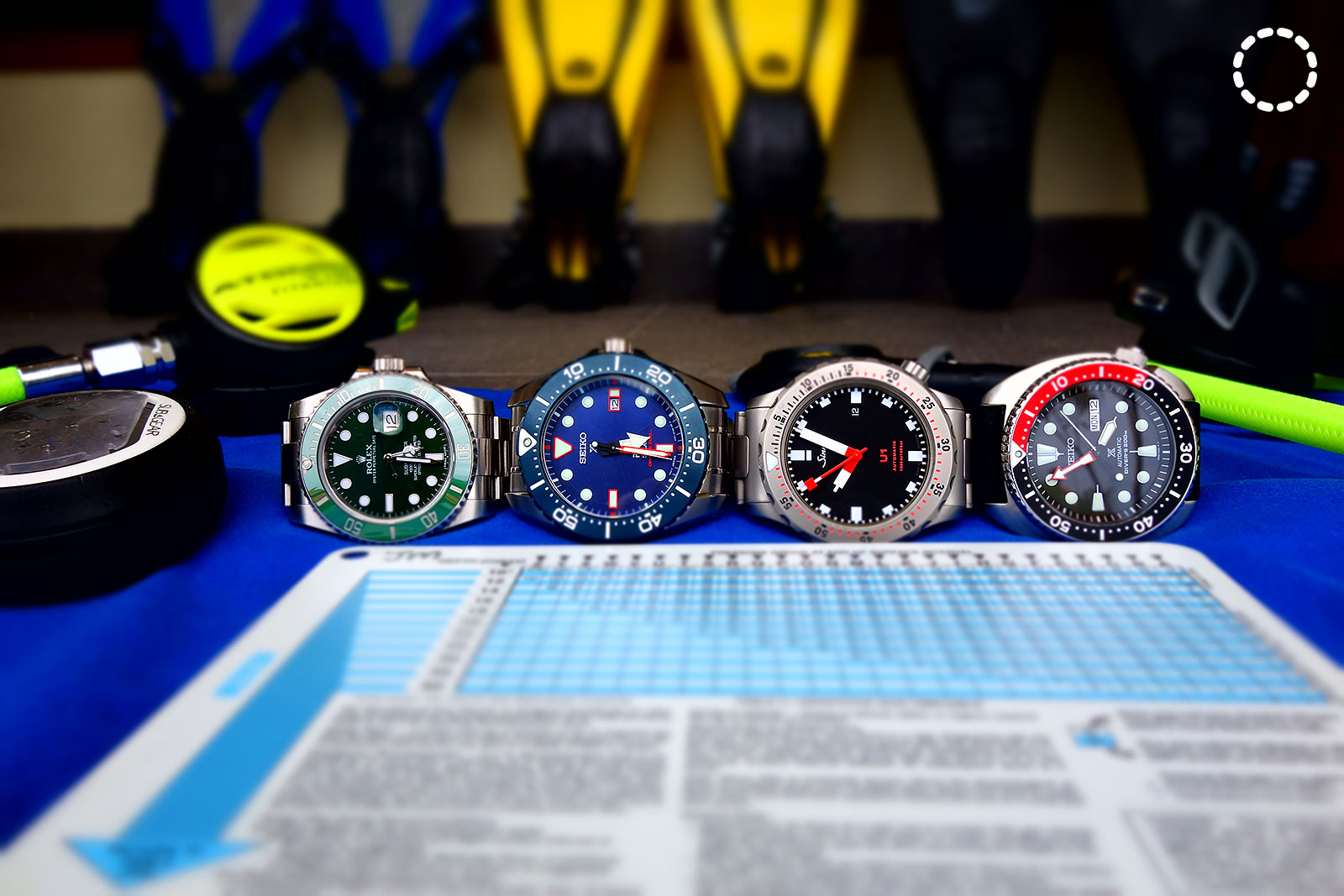
Being a scuba diver [Ed’s note: the author is a PADI Master Scuba Diver and PADI Emergency First Response (EFR) Instructor] and a watch enthusiast, I decided to put a few well known – and respected – dive watches through their underwater paces on a diving trip that took place in December 2016 off the island of Bali, primarily around the village of Tulamben.
The four watches I brought along this time were – Rolex Submariner “Hulk”, Sinn U1, Seiko Prospex Scuba Diver PADI Titanium, Seiko Prospex “Turtle” – a range of dive watches that were conceived and all built for the same purpose, but are at vastly different price points. However, all four are widely respected as proper dive watches.
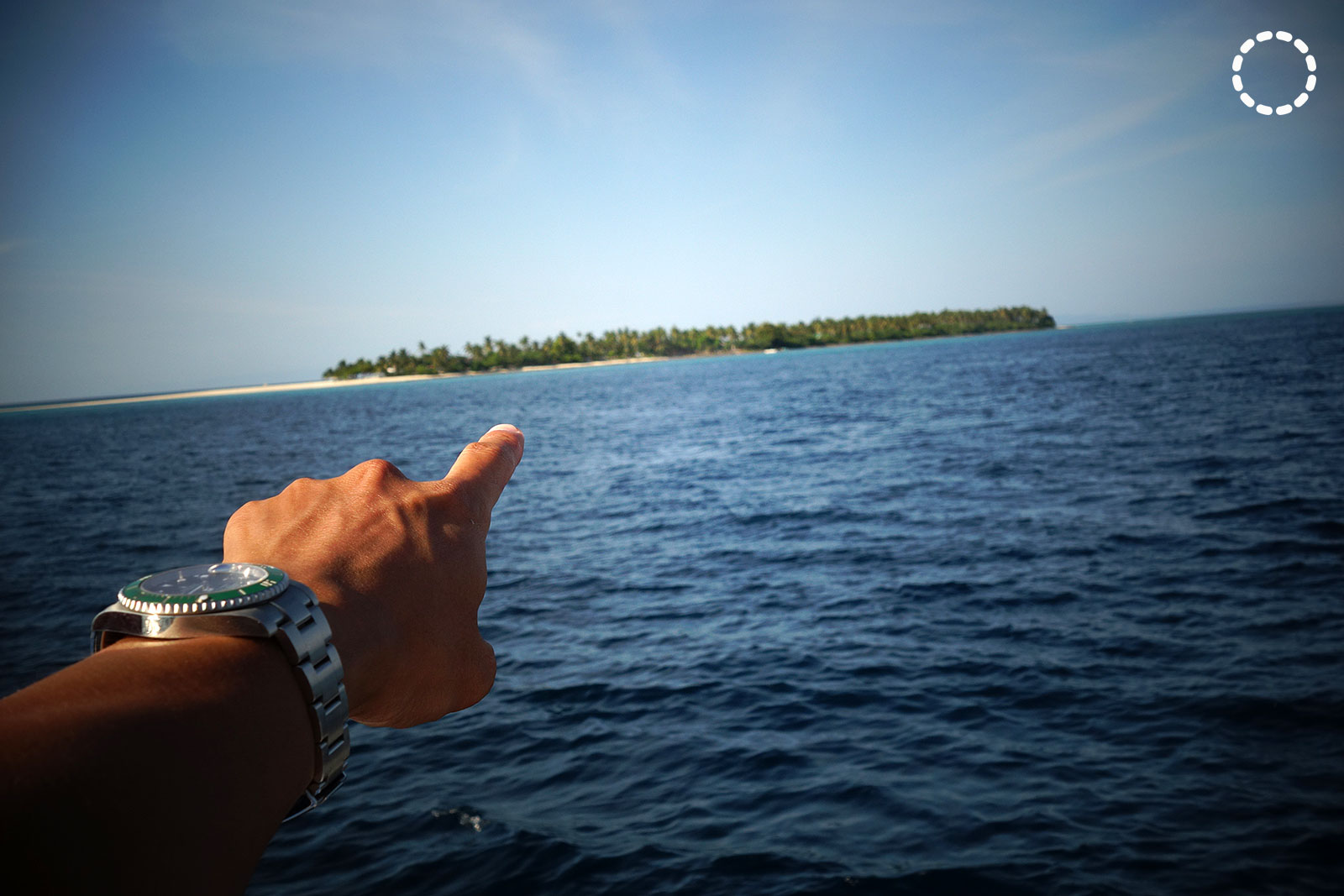
The Submariner “Hulk” (ref. 11610LV) was bought new in 2013 and has been worn on over 250 dives. It has graced the land and sub-surface duties of exotic locations worldwide and has also been worn in rotation with other watches as the “desk diver-daily beater”.
One of the best features of the Submariner is the Triplock crown that has a crown tube equipped with three sealing points – hence the “triple lock” name. The most visually reassuring of the three sealing points is the black o-ring visible on the threaded crown tube. It can be seen by the owner each time the crown is unscrewed on any Triplock equipped Rolex.
To date I have not come across another brand with such a robust and impressive crown construction and design. It gives extra confidence to the wearer, especially if one is actually diving, since the crown is often the weakest point of the case. All other watches I have seen to date only have an ordinary screw down crown.
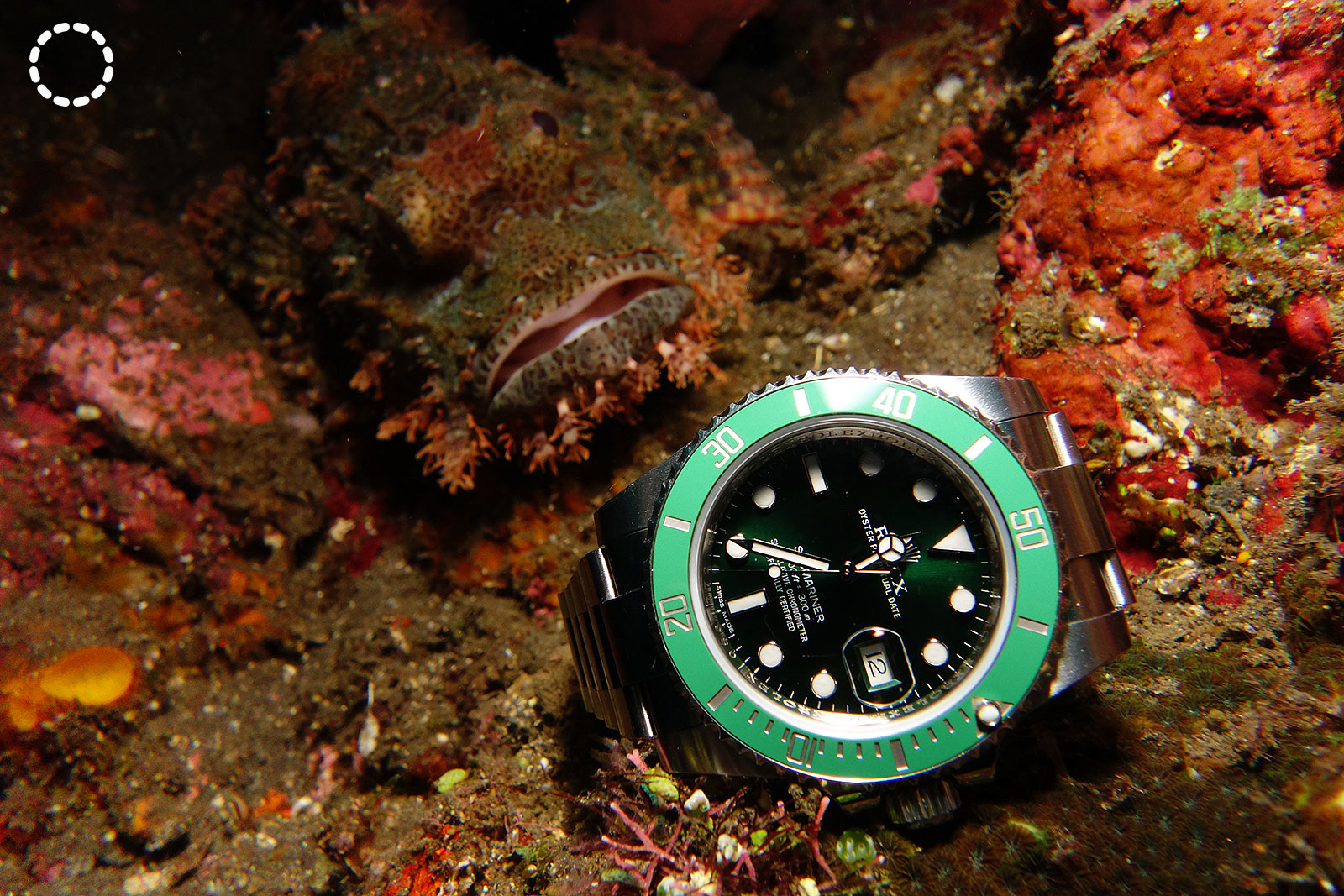
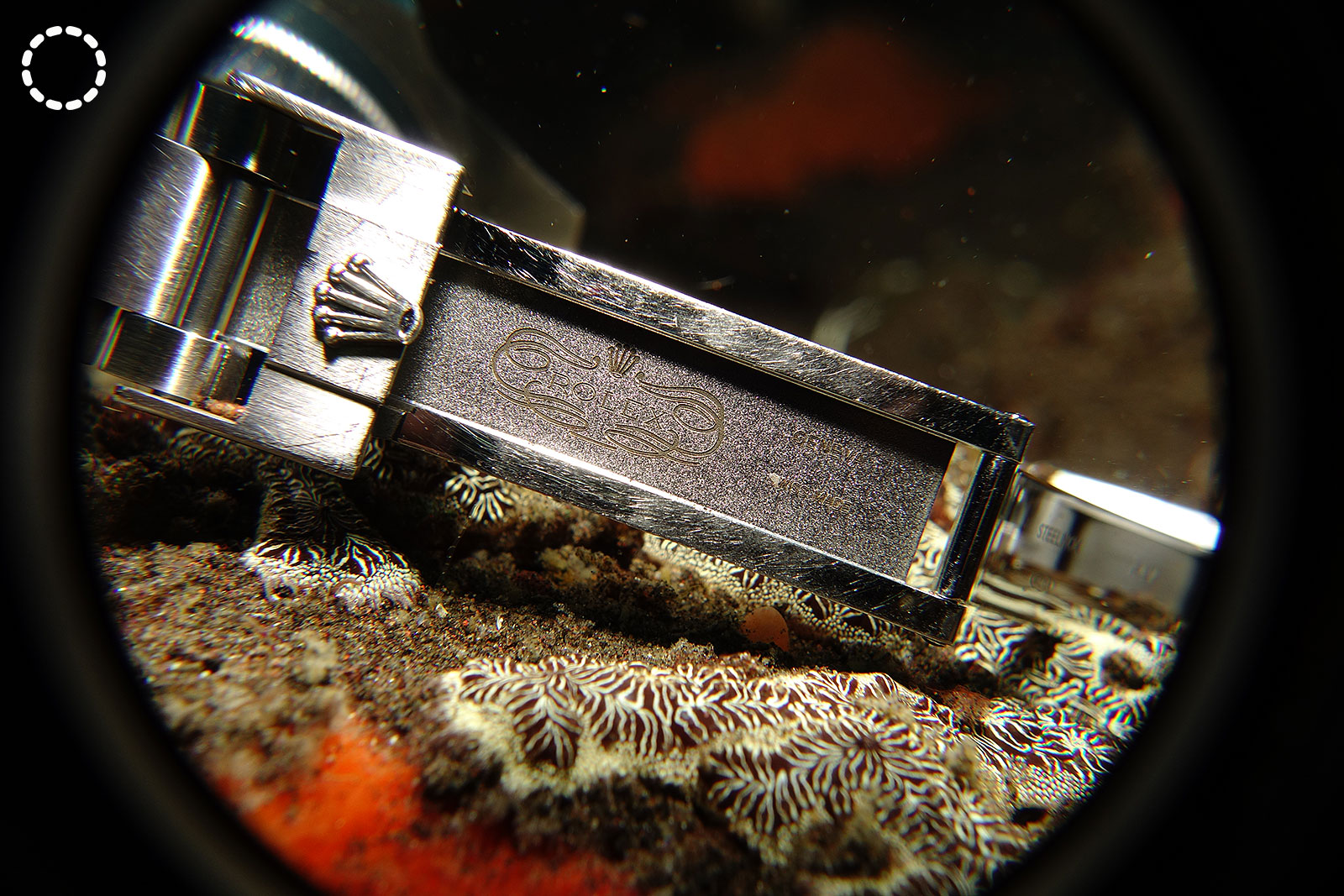
Point to note: the Submariner, despite being conceived as a proper dive watch, does not come with the wet suit extension that is standard on the Deepsea Sea-Dweller. Though both the Submariner and Deepsea Sea-Dweller are listed as having the Rolex patented adjustable Glidelock clasp, the Submariner has a simplified and shorter version of Glidelock that can only adjust within a range of 20mm, compared to the 26mm of the Deepsea Sea-Dweller’s clasp.
However, the Deepsea’s wetsuit extension can be fitted as an option to the Submariner. The wetsuit extension on my Submariner was purchased separately and fitted at the Rolex Service Center for a rather princely sum.
The Sinn U1 (ref.1010) made its debut at Baselworld 2005, I placed an order as soon as I saw pictures. Mine has a very early production serial number and I believe it’s the first U1 delivered in Singapore. It was originally delivered on a rubber strap; the bracelet was added later in 2013 during a trip to the Sinn factory in Frankfurt.
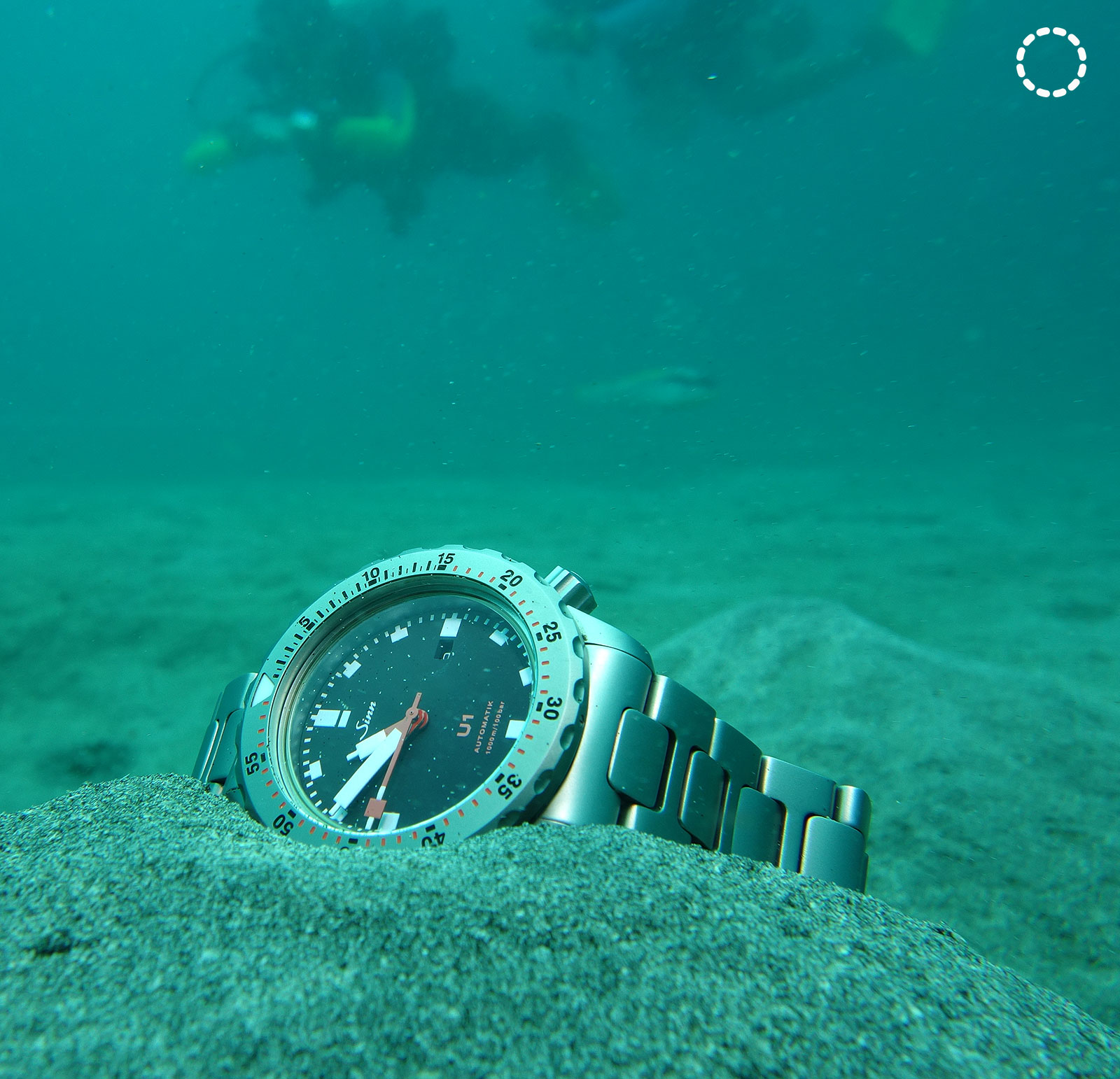
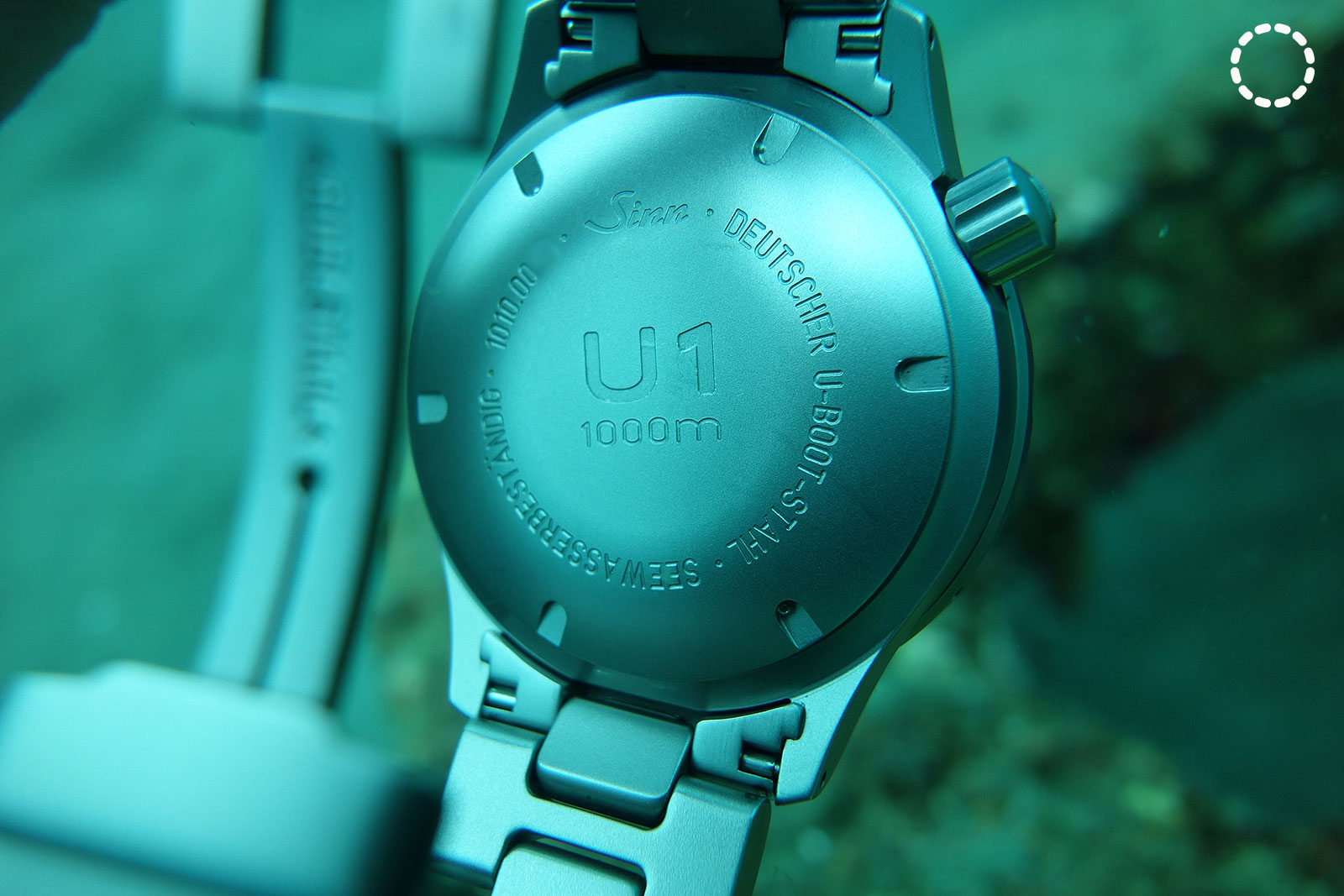
It had been worn as the sole daily beater for five years from circa 2005 to 2010, then kept in storage but taken out for the occasional dive. The Sinn U1 has clocked up approximately 50 dives to date.
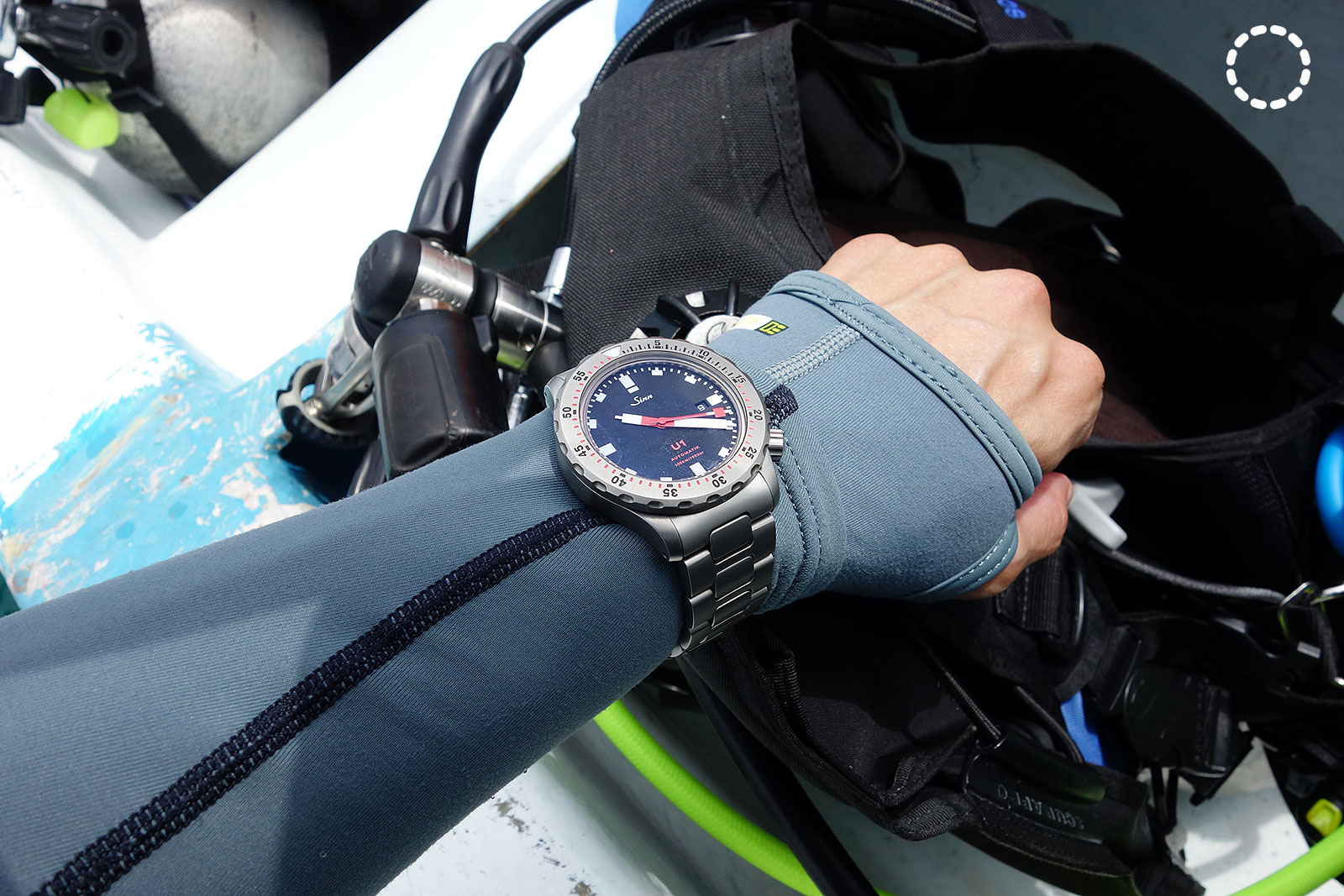
The highlight is the case made of submarine steel plus a bezel that’s undergone Sinn’s proprietary Tegiment surface hardening process. Therefore anytime the watch was pitted against my car’s bodywork, the watch always won. Despite being used as a daily beater and being more than 10 years old, the condition is amazing. This watch is super tough timepiece.
It’s interesting to note that the Sinn U1 available today only has the Tegiment surface hardening applied to the bezel, while the watch case is no longer treated. The movement in the current versions is a Sellita SW200-1, essentially a clone of the ETA 2824 used early in production.
The Seiko Prospex Divers “Turtle” (ref. SRP789K1) is steel, with the calibre 4R36 inside is the latest iteration of “Turtle” divers form Seiko starting with a long history from the original 1965 ref.61217 (a.k.a. 62MAS). The 4R36 is modern day automatic ticking away at 21,600bph, containing 24 jewels, day-date function, with a hacking seconds hand. This was brought for the trip to compare against the other watches.
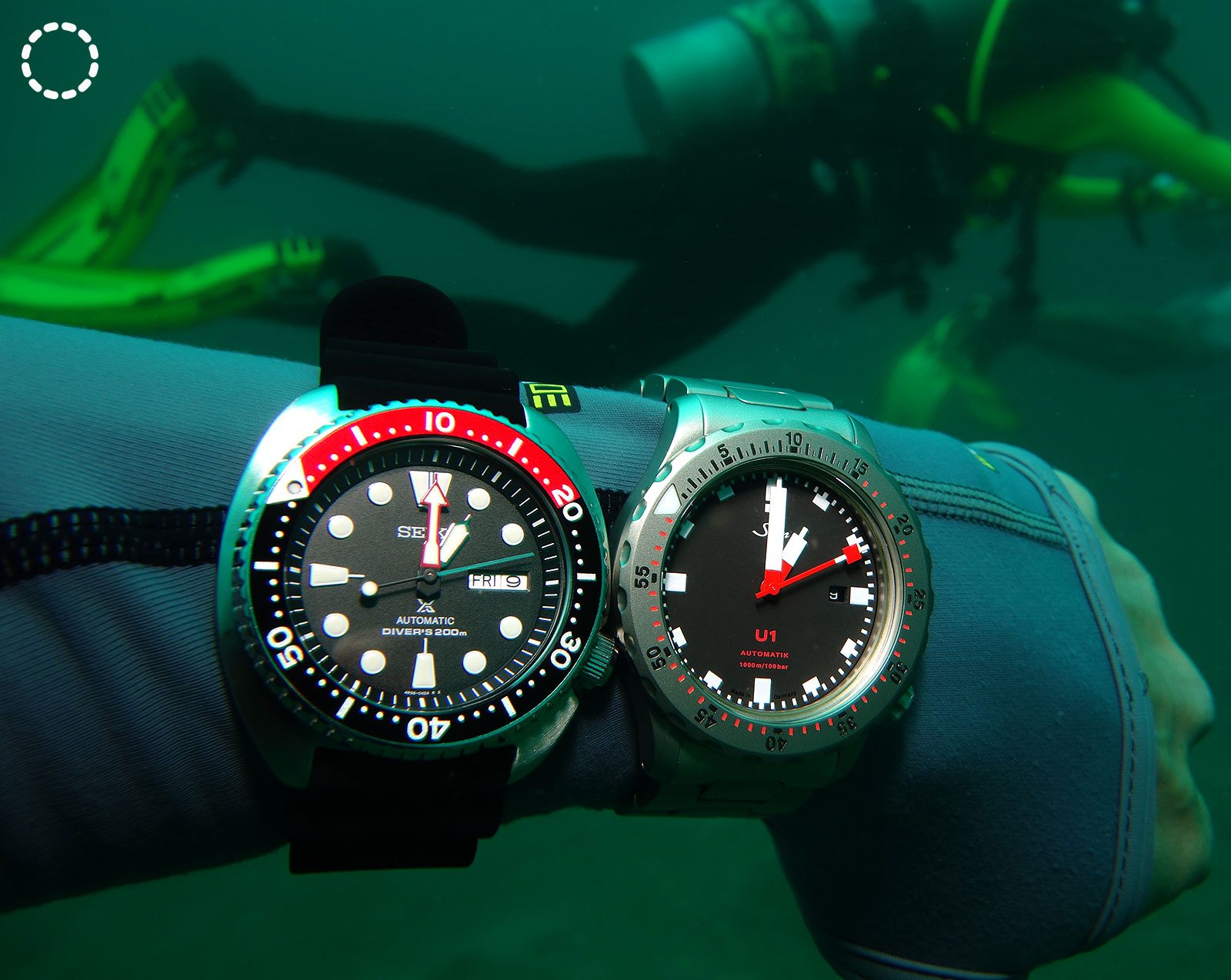
This is the newest of the four here is a Seiko Prospex Scuba Diver PADI Titanium (ref. SBDJ015) that is a Japan-only limited edition of 1800 pieces. It is a titanium based watch and deceptively light weighing in at 99 grams for largish looking 44mm dive watch. Inside sits a quartz movement, Seiko cal.V157 which is recharged by exposing the watch face to sunlight and has a power reserve of up to 10 months.
Seiko have also finished this watch with their proprietary ‘Dia-Shield’ coating which is actually pretty hard wearing and scratch resistant in real world use. The coating is probably chemically bonded to the metal surface with a technique similar to PVD (physical vapour deposition) as the watch was pretty resistant to scratching from all the underwater manhandling and placement on jagged coral.
It was released in Japanese stores on 27th November 2016 and I managed to get it on the day it hit the streets in Tokyo. I thought it might be fittingly epic to have a “PADI” co-branded watch on the trip to test it out.
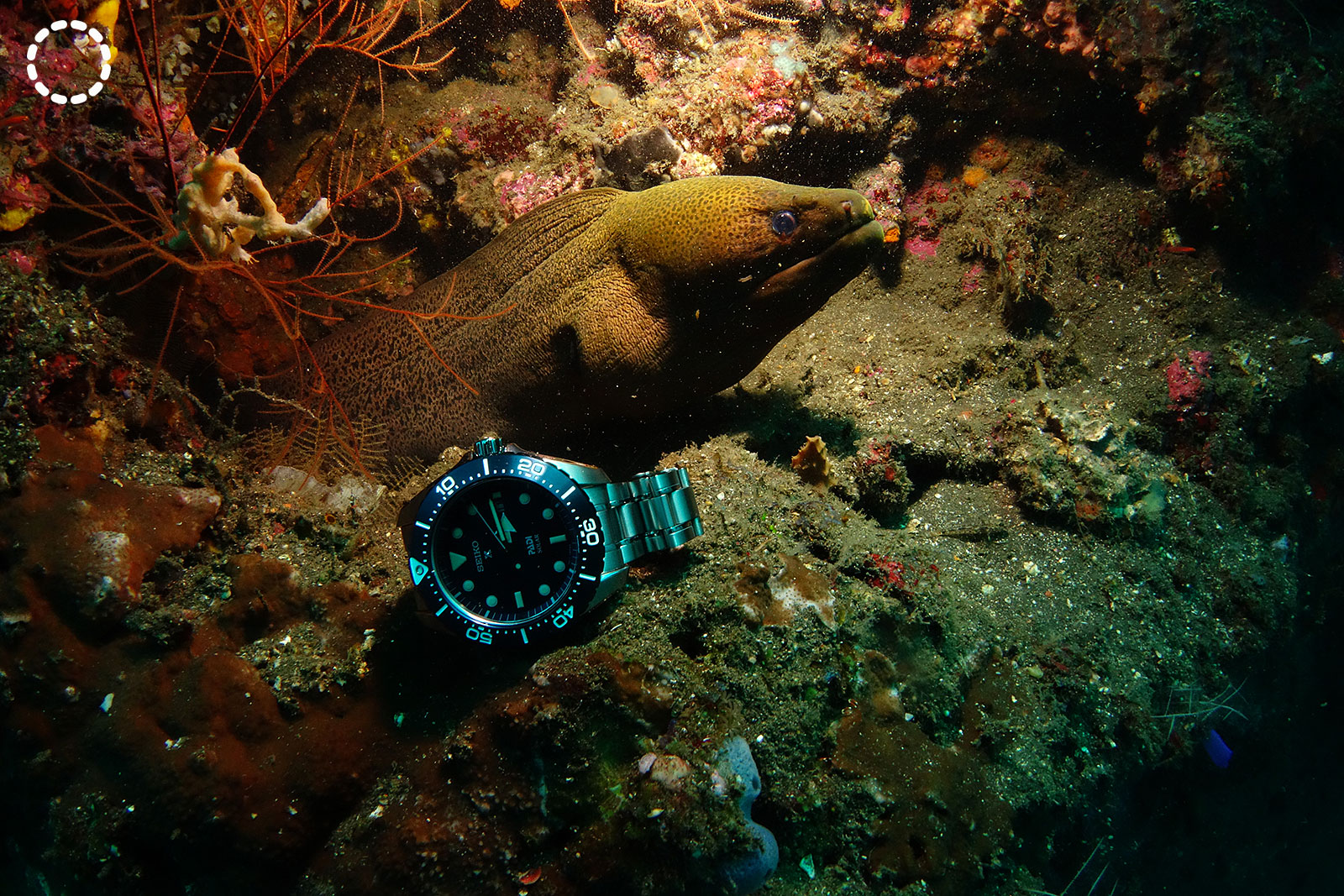
Bracelets, straps and dive extensions
All the bracelets for each of the watches have an extension to allow the watch to fit over a wetsuit. But the extension is not actually practical when a wetsuit is worn. That’s because the extensions are all a fixed length when unfolded, though varying in length from brand to brand.
In varied diving conditions – you may require no wetsuit, a 1mm thick wetsuit or perhaps even a 5mm wetsuit for colder waters – the implication is that the actual circumference of the wrist changes depending on where you are diving due to wetsuit thickness. Fixed length bracelet extensions don’t do the best job since they may be too tight or too loose.
The best solution to date is the Submariner Glidelock clasp that is adjustable within its range, being able to accommodate most diving conditions with an extension of up to 20mm. When used in conjunction with the wet suit extension from Deepsea Sea-Dweller, this combination of Rolex bracelet has almost infinite adjustability for whatever the undersea configuration may demand.
Actually, truth be told, the most important point about the Submariner is that between dives you can adjust the bracelet correctly to fit your bare wrist for lunch at the beachfront restaurant or atop the boat deck. Perfect!
A rubber strap also provides very good infinite adjustability like the Rolex Glidelock – from wetsuit overlay to lunch on dry land. The rubber strap of the Seiko “Turtle” has a steel keeper on the end, which tends to move as the keeper is loose even with the other end of the strap threaded properly through it. So the solution was to add a pair of rubber o-rings to the strap – a simple enough fix that keeps the steel keeper in place. The o-rings come from a common spare part kit for scuba tank valves.
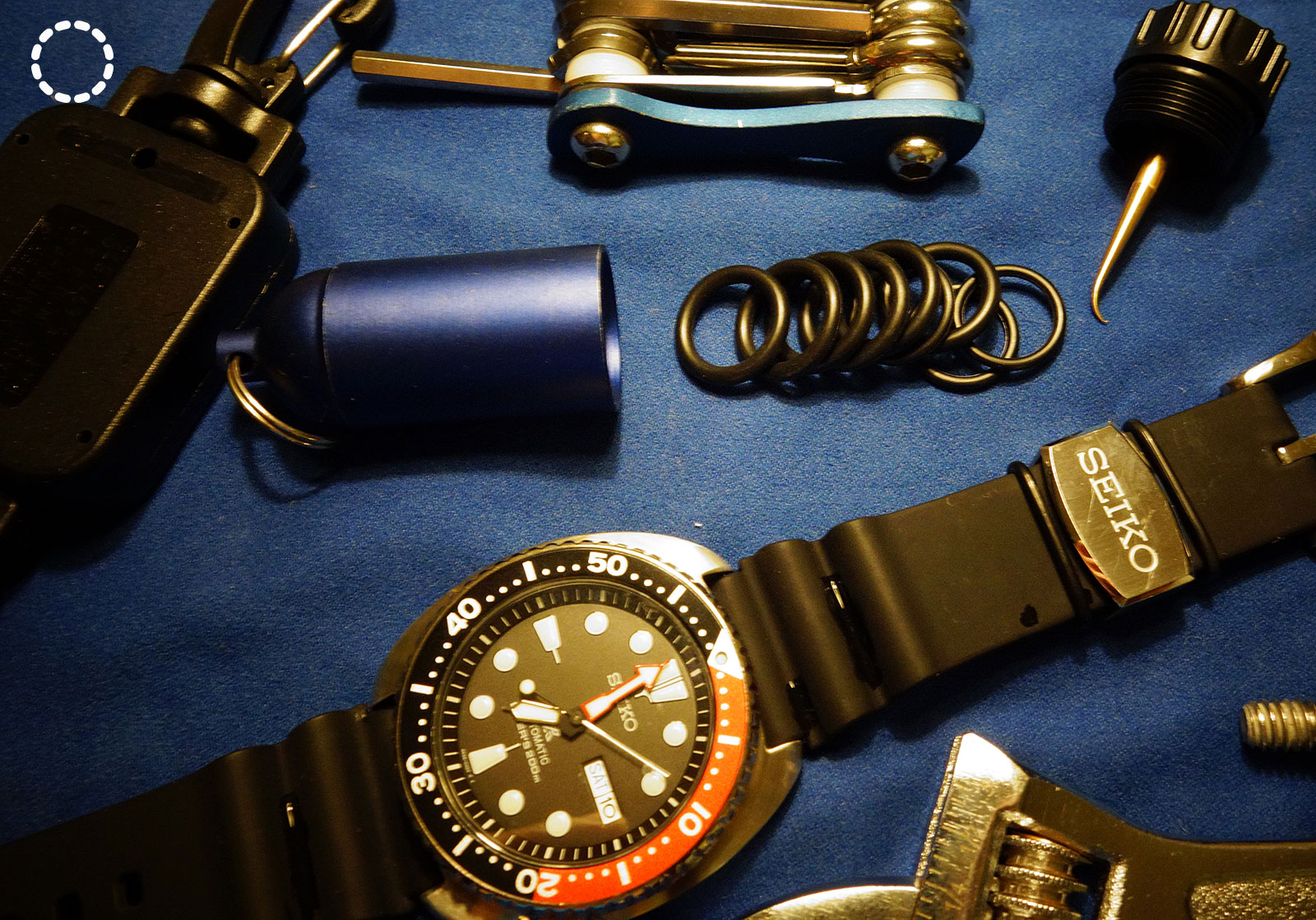
Bezels… but first a diversion into deco diving
It is widely accepted that you set the bezel of a dive watch at the start of a dive to time its the duration by rotating the bezel’s 12 o’clock to be in-line with the minute hand, which is why all dive watches have elapsed time bezels.
But that is an outdated method that uses time and depth based on old U.S. Navy dive tables. For the interest of safety, nobody really uses that now, PADI have now made it mandatory for all Open Water students to use a dive computer. A dive computer is a device that calculates automatically and dynamically the no-decompression, or “no-deco”, time remaining at whatever depth you are currently at.
A no-decompression dive is the standard modus operandi for PADI and general recreational diving – you are not allowed to enter “deco” – and you end these dives with only one decompression stop, usually called a safety stop, whereby you ascend to 5m and stay for three minutes as your body off-gasses the dissolved excess nitrogen in your bloodstream.
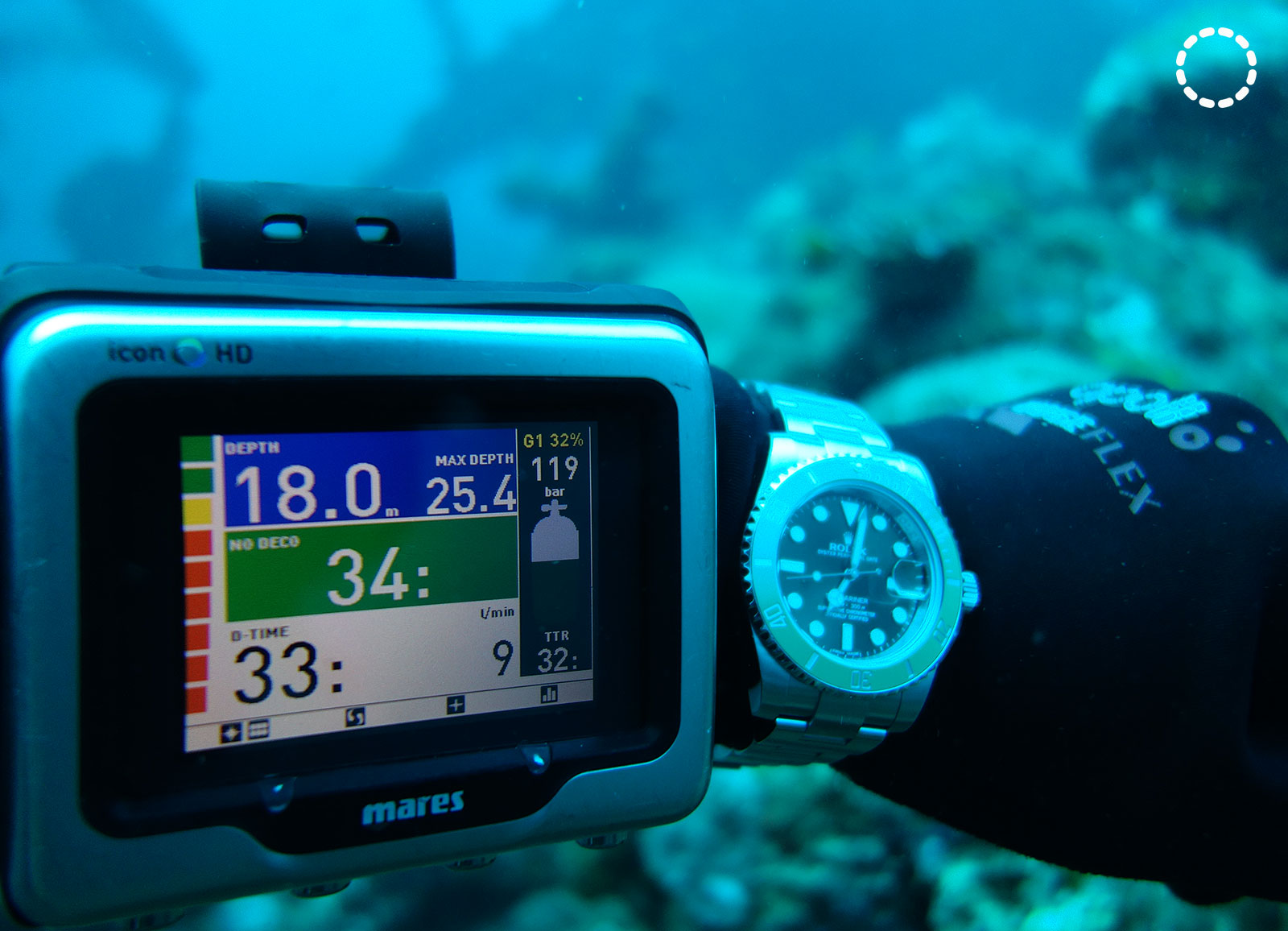
That contrasts with decompression, or “deco”, diving. In order to managed the dissolved gas in the bloodstream after diving to deep depths or for long duration, on the ascent to the surface the diver stops at various shallower intermediate depths in order to off-gas the excess nitrogen in stages.
This may call for multiple stops, for example eight minutes at 18m, then a further five minutes at 12m, and so on. However, this is multiple depth stopping is not allowed in recreational diving, as you may run out of air (you have only one scuba tank on your back). Deco diving is usually done by technical dive enthusiasts or professionals for industrial purposes, for instance working on offshore pipelines or oil rigs.
Both deco and non-deco diving calls for complex calculations based on mathematical models, of which there are two common types: the Bühlmann decompression algorithm and the reduced gradient bubble model (RGBM), an algorithm developed by Dr Bruce Wienke. Most modern dive computer manufacturers will used modified forms of either model to programme their dive computers, automating the process.
The bezel on a proper dive watch can only be rotated anti-clockwise for safety reasons. You mark the start of the dive on the bezel with the 12 o’clock bezel marker and if you subsequently accidentally move the bezel, the unidirectional movement can only reduce the measured duration of the dive – a built-in safety feature.
You cannot dive with a bidirectional bezel – if you accidentally knock the bezel and it rotates clockwise you may inadvertently extend your dive time – and there may not have enough air left in the tank or you may inadvertaently go into decompression part of the dive table!
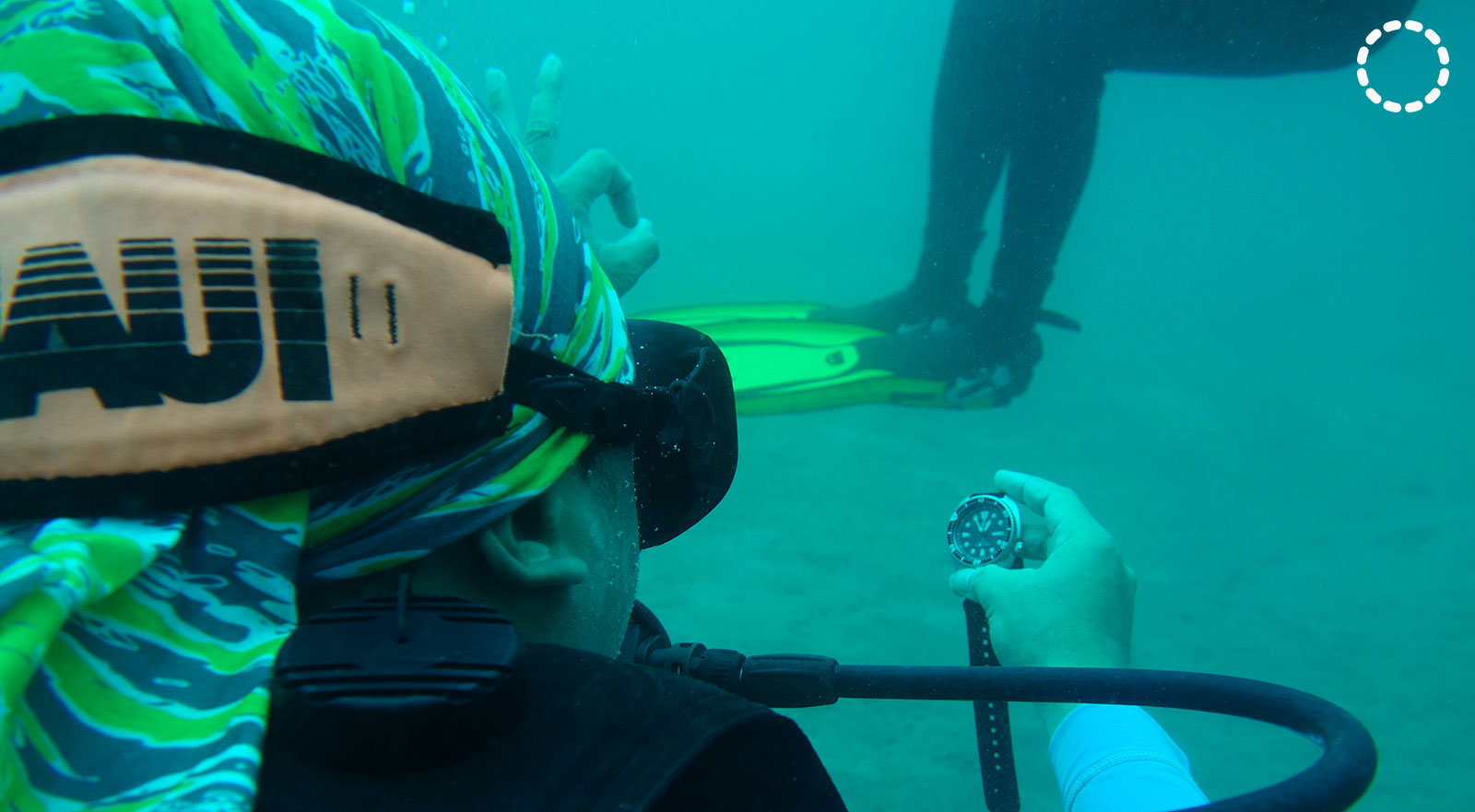
So it’s primarily a historical legacy that dive watches have bezels as dive timers, since all functions today dealt with by a modern dive computer. But since all dive watches have bezels, we will look at their real world performance.
The easiest to manipulate underwater, even with gloves, are the bezels on the Sinn U1 and Submariner, followed by the Seiko Prospex Scuba Diver PADI Titanium. The Seiko “Turtle” bezel felt a bit too tight underwater and not enough grip. More importantly, the slightly chamfered design of the knurled edges on the Submariner and U1 were the best, giving the most grip. This was followed by the Seiko Prospex Scuba Diver PADI Titanium.
The edge and feel of the bezel on the “Turtle” unfortunately this watch come in last for underwater bezel feel, the size of the knurled bezel edges was adequate it didn’t feel ‘grippy’ enough especially if you have on very smooth gloves. If you closely at the design of the Seiko “turtle” bezel there is no pronounced chamfering (angling of the grip surface circumference away from the centre of the watch). For grip to be applied to the Seiko “Turtle” you have to place your fingertips on the bezel and apply a force more or less parallel to the plane of the watch dial and then rotate.
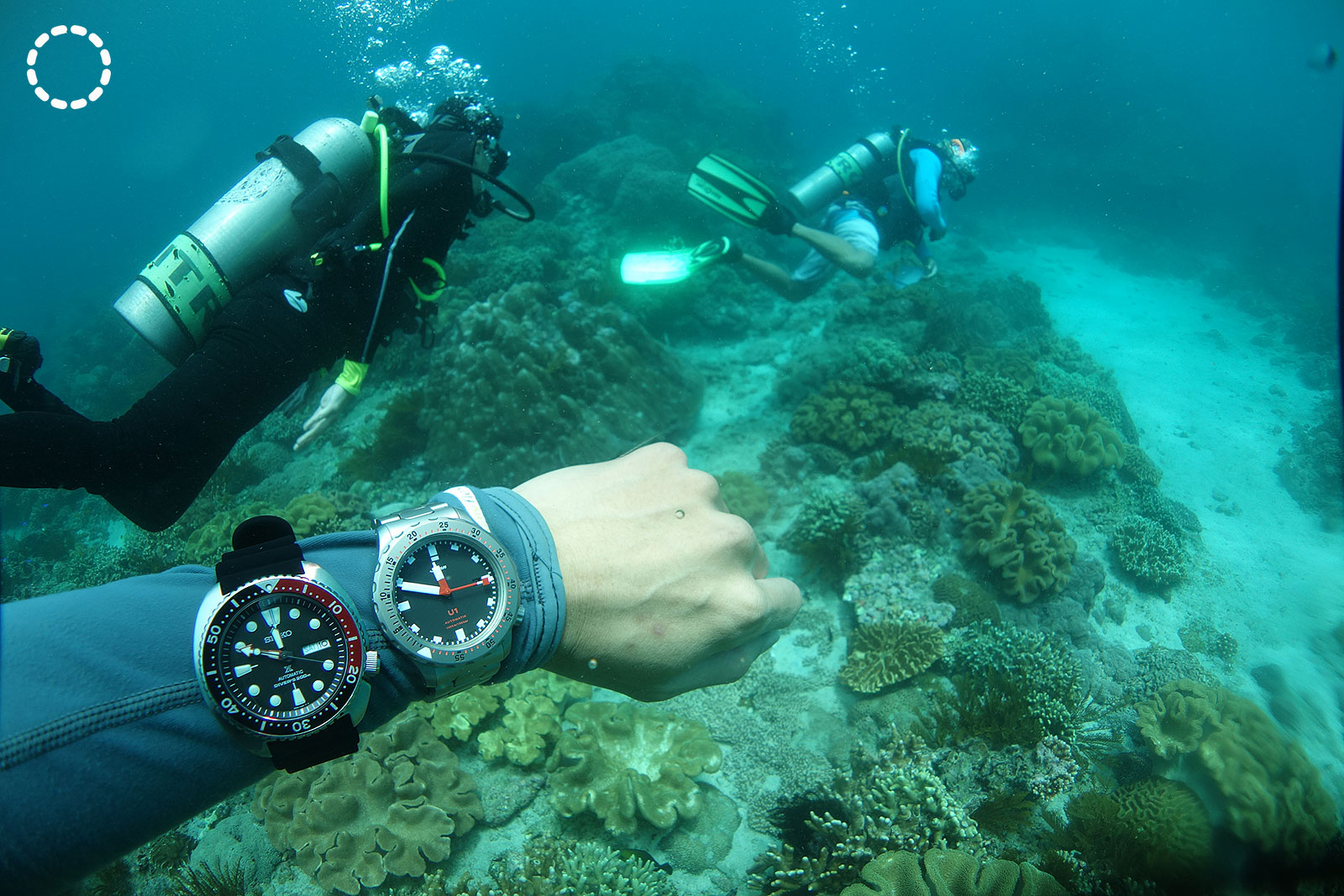
In reality when you do this underwater there is more often than not there is an element of a secondary a vertical force applied pushing into the face of the watch face. This probably explains why the watches with some chamfering in the design or bezel equipped with a slight angle at the edges are easier to manipulate underwater than watches without this chamfering on the edge.
For bezel robustness the Sinn U1 would win it hands down. If you look carefully at the U1’s bezel you will find that it actually has tiny screws which need to be removed before you can even think of removing a U-series bezel. Sinn designed the U1 to have a “captive bezel” attached to the central part of the case. The ratcheting is a sophisticated bearing system and combined with a slightly radically offset locking pin position to protect the toothed ring guarantee reliability and a bezel that does not detach when harsh impacts are applied.
Almost every other watch here has a friction fitted bezel including the Rolex. Friction fit bezels are easy to remove and can be done easily using a watchmaker’s caseback opening knife tool to pry the bezel off. Seiko is probably the easiest to pry off and explains the large secondary market of third party bezels available for “modders” to change the original cosmetic look of the Seiko “Turtle”.
Legibility and the seconds hand
All four watches have decent readability underwater, and all fulfil the ISO 6425 standard criteria for dive watches.
According to the ISO 6425 standard for dive watches, the seconds hand must clearly be marked with luminous material. In a quartz dive watch the standard calls for a clear end of life (EOL) indicator that prominently shows the battery is running down so the watch owner knows the power is low on the diving instrument.
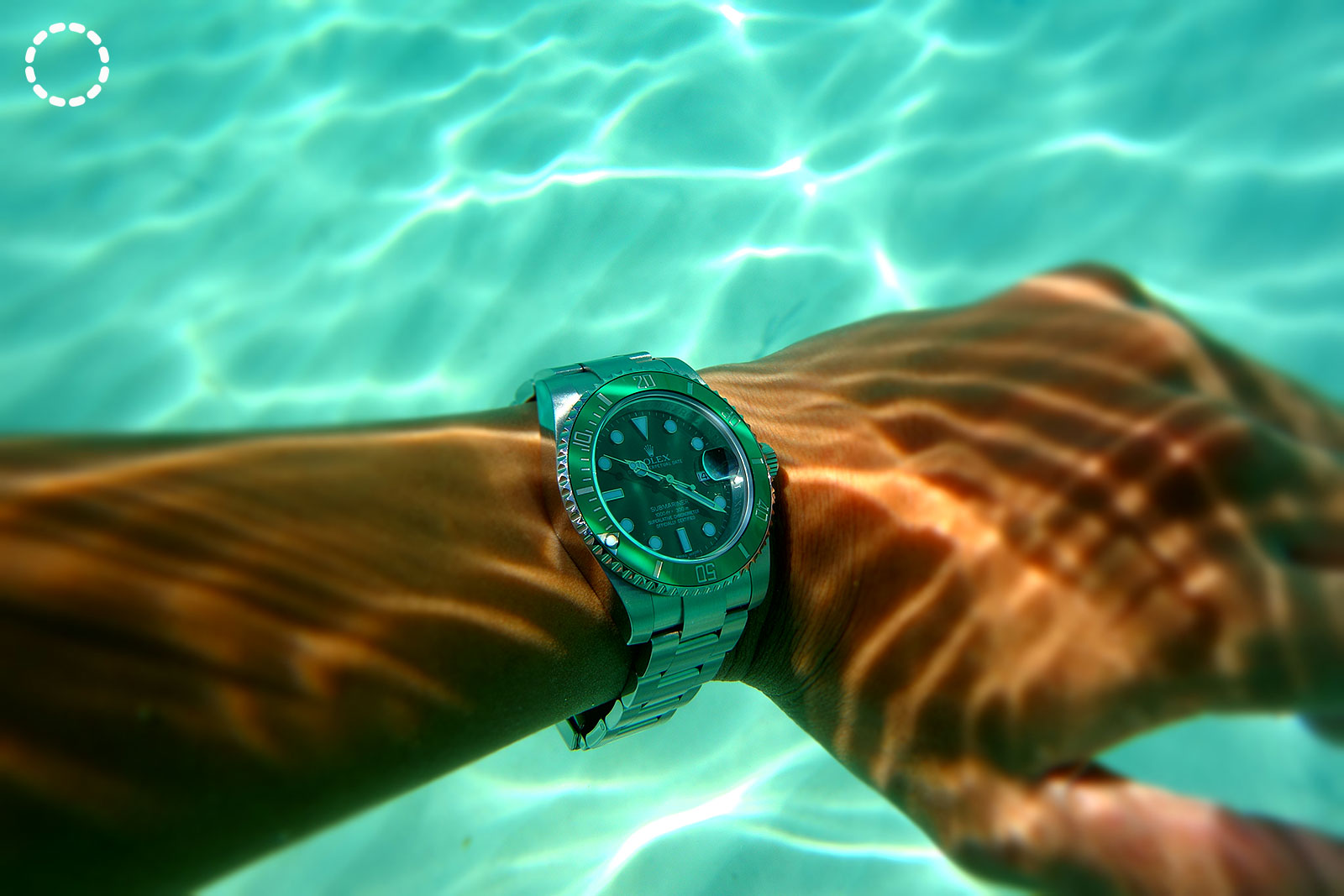
So why do all dive watches need a visible moving second hand?
Safety!
The watch must be running to be able to time the dive. A visibly moving seconds hand is the underlying key to that. If the seconds hand stops, the watch is dead and you should end the dive, or you may run out of air or enter decompression dive territory – either way you are in trouble. So the trick underwater when you look at your watch is to always look at the second hand first, make sure its running, then you know you have a functioning instrument – thereafter you can proceed to look at the time elapsed for which you earlier lined the 12 o’clock bezel market to minute hand position at the start of the dive.
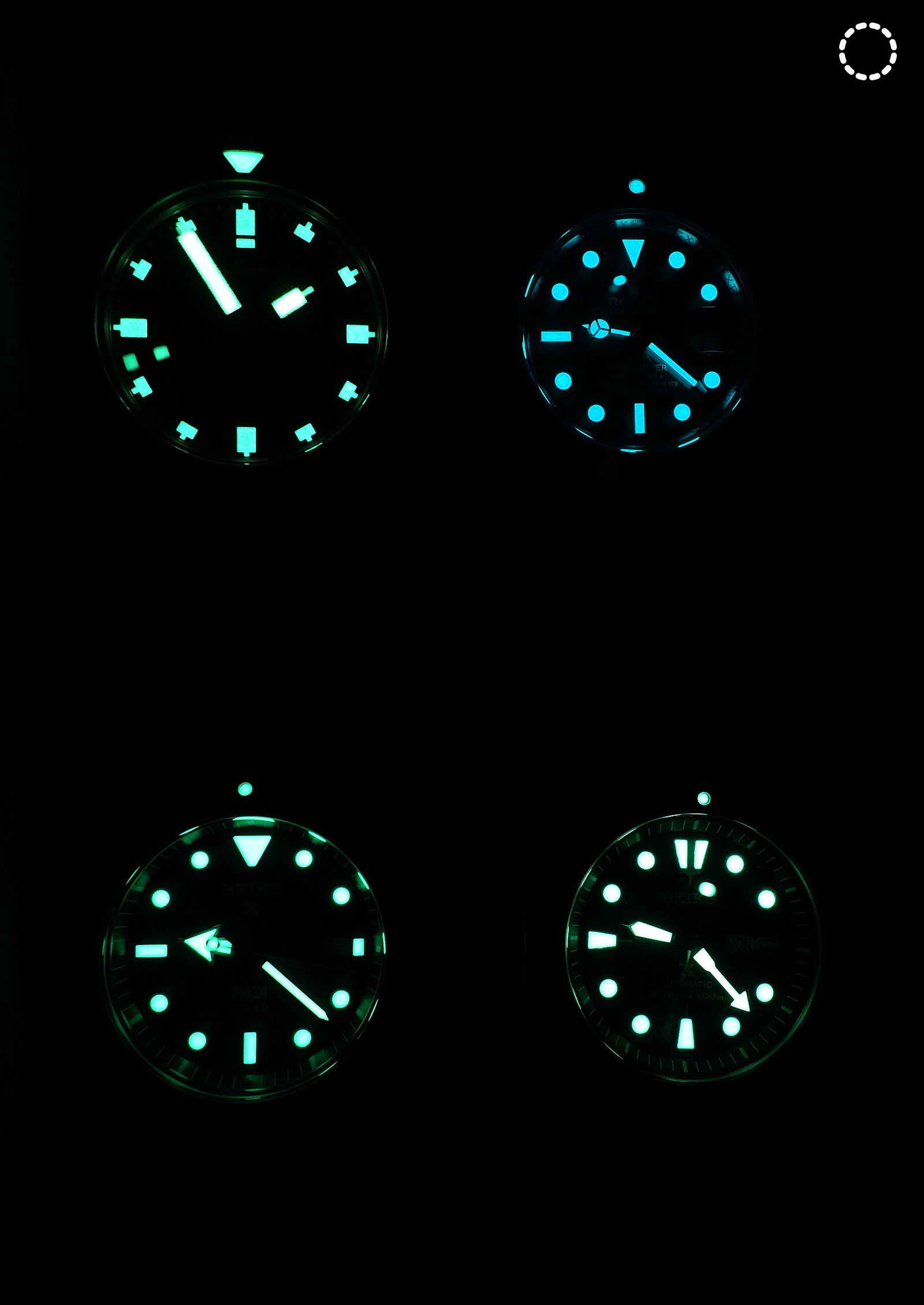
Clockwise from top left: Sinn U1, Rolex Submariner, Seiko Diver “Turtle”, and Seiko Prospex Solar Scuba Diver PADI Titanium,
Both Seikos have a circular lume dot on the counterweight side of the second hand, opposite the tip that points to the seconds. However, the Rolex lume dot is on the same tip side of the second hand. But either way it does not matter as both serve their purpose.
The Sinn U1 was the hardest to read underwater at night as the lume on the seconds hand is thin sliver of white that’s next to a large red square that does not glow. (Note: that in the above photos the tip of the second hand appears larger than it is as the seconds hand was moving during the exposure)
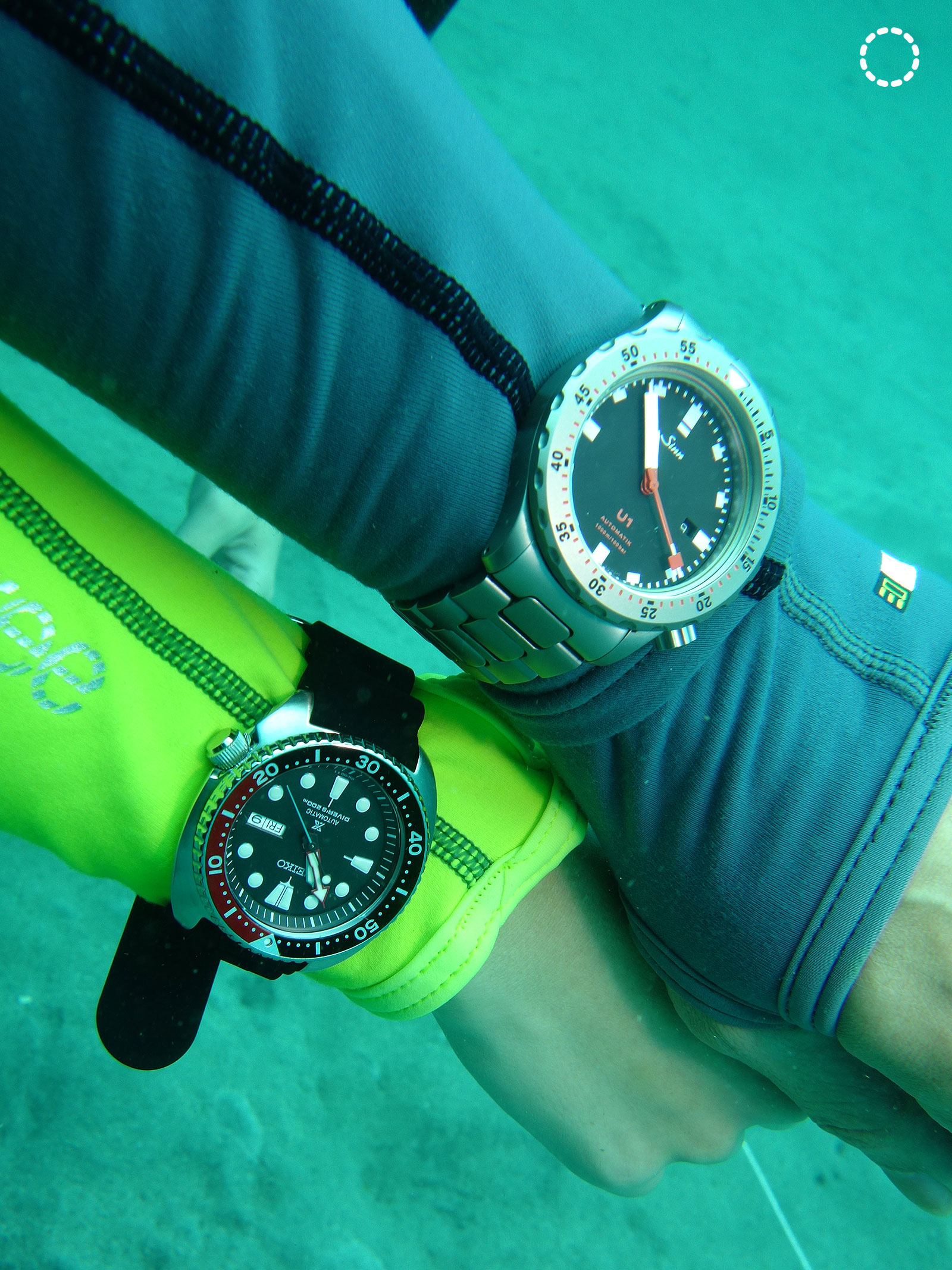
The Seiko watches take the prize for brightest and longest lasting luminosity in dim lighting. Seiko uses Lumi Brite for its watch hands and dials, which is essentially Super-Luminiva doped with the rare earth elements Europium and Dysprosium for a brighter and longer lasting glow. Chemically speaking Lumi Brite is strontium aluminate doped with Europium and Dysprosium (SrAl2O4 + Eu + Dy).
Super-Luminova, which is what is used on both the Rolex and Sinn, is just on strontium aluminate without the rare earth elements.
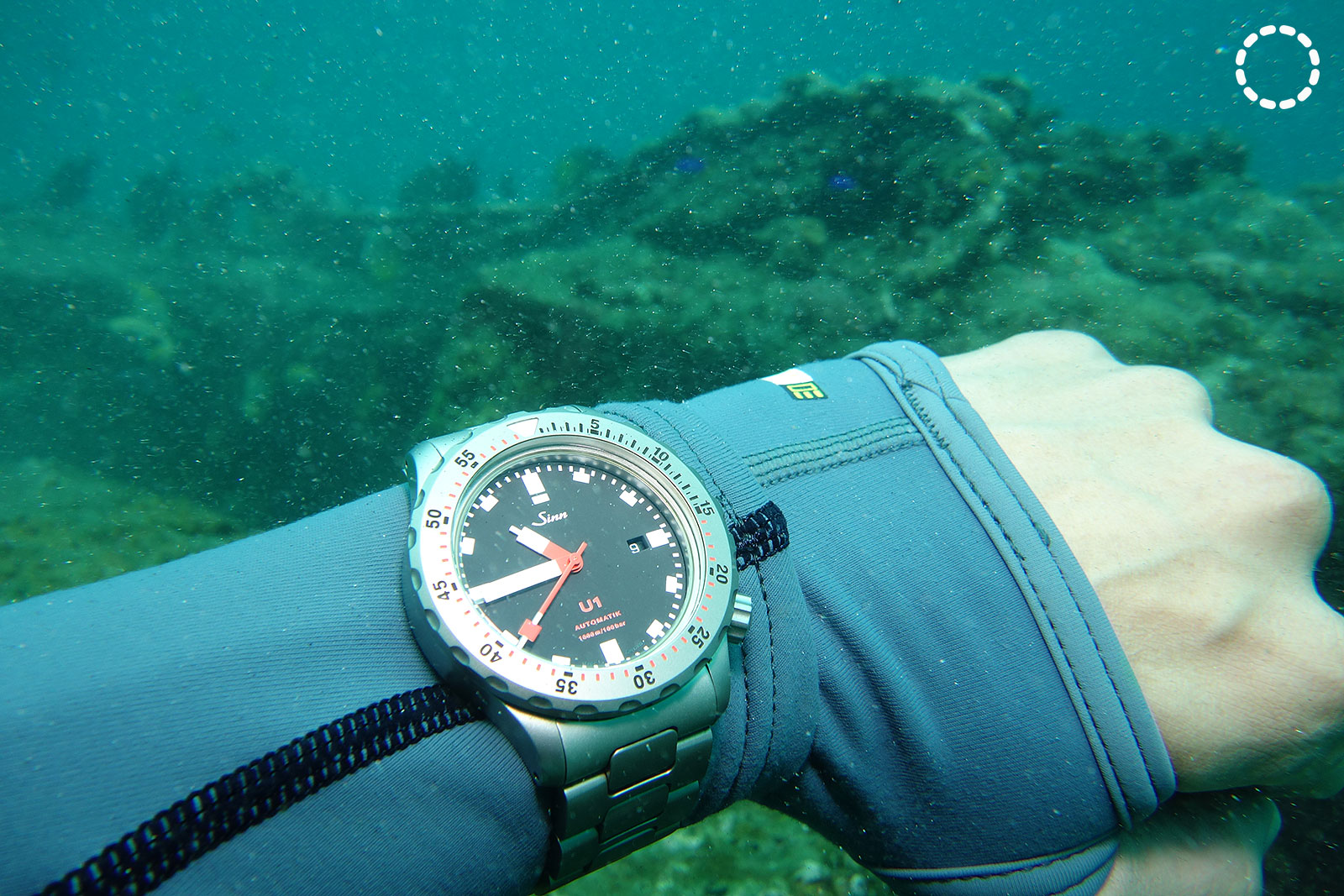
Why the colours on a dive watch dial matter underwater?
Red light does not reach the depths of the ocean – explaining why there are so many marine creatures that are red in color – as colours disappear underwater in the same order as they appear on the colour spectrum. Red is the first to go, followed by orange, yellow, and so on. Even at the shallow depth of 5m you start to see the loss of red colour, so the deeper you go, the more pronounced the colour loss.
The PADI Advanced Open Water Diver Slate, photographed up on the surface under sunlight, shows the colour spectrum and the red is vibrant.
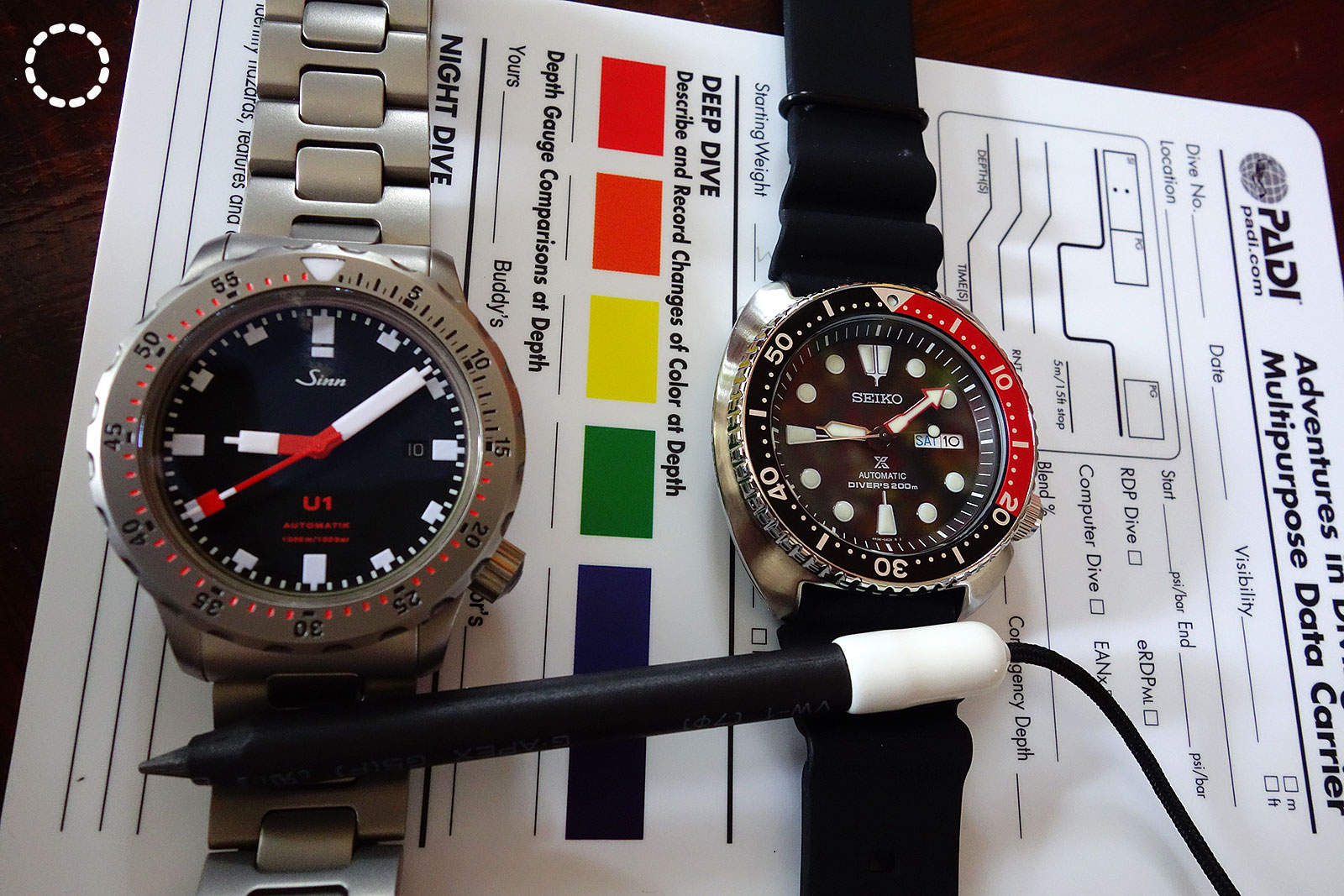
Now look at the same slate at depth, in this case at a depth of 25m. Notice how all the colours don’t look normal anymore – red has effectively turned to brown. The picture below has been deliberatly taken without the use of underwater flash photography to illustrate the loss of color at depth.
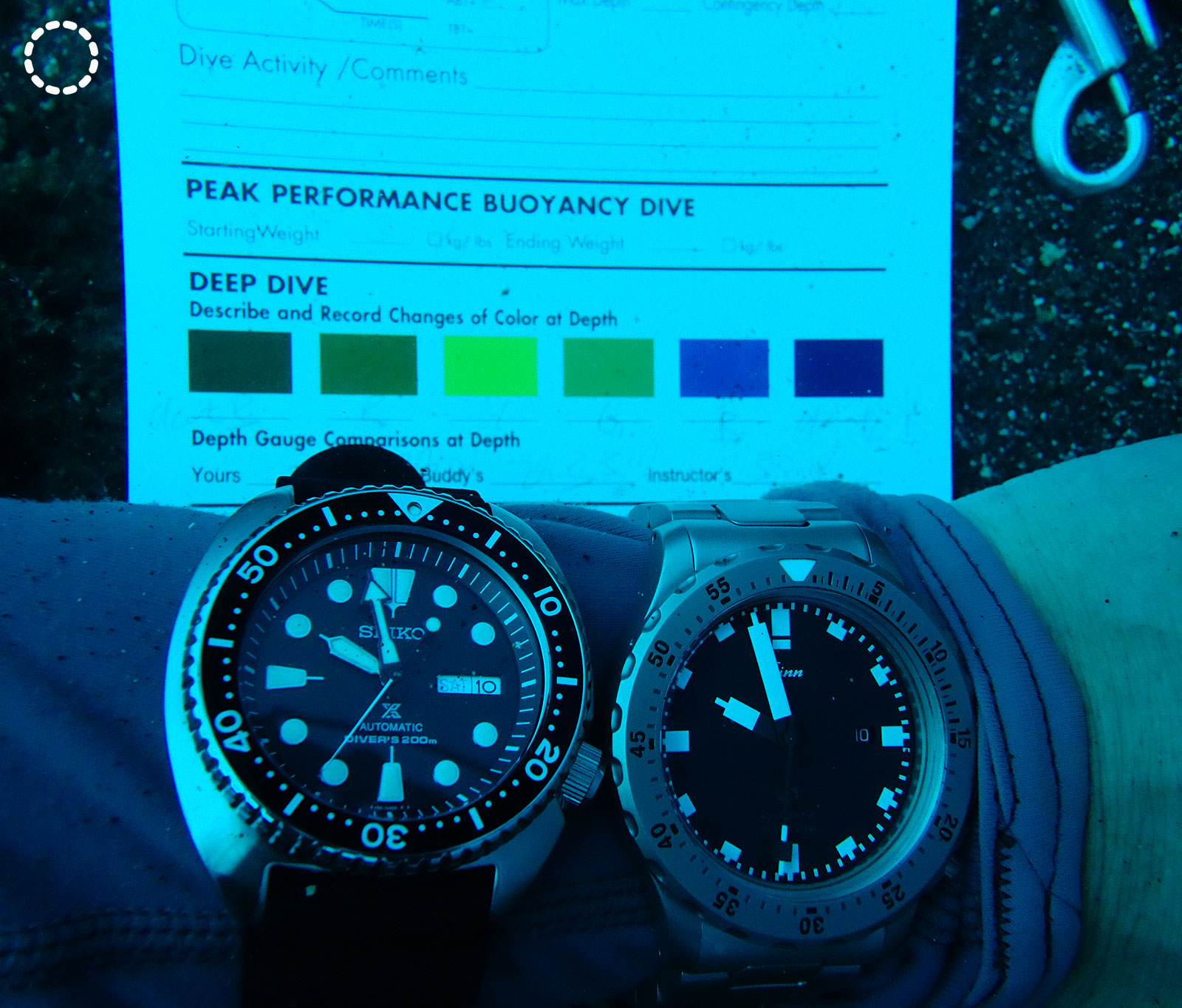
The watch-related lesson here is, on the surface the bright red hands are awesome and legible, but underwater they are not – they look a shade of dark reddish-brown, especially at depth.
The most visible color underwater that tends to not change with depth is bright yellow. For that reason safety equipmemt like the diver’s alternate air source, known as the octopus, as well as most other emergency underwater equipment are all yellow for high visibility underwater.
Look at the Spyderco Salt Assist H1 Rescue knife next to the Sinn U1 (with its red hands) underwater. The bright yellow handle of the knife is still clearly visible as yellow, while the red on the Sinn dial looks oxblood.
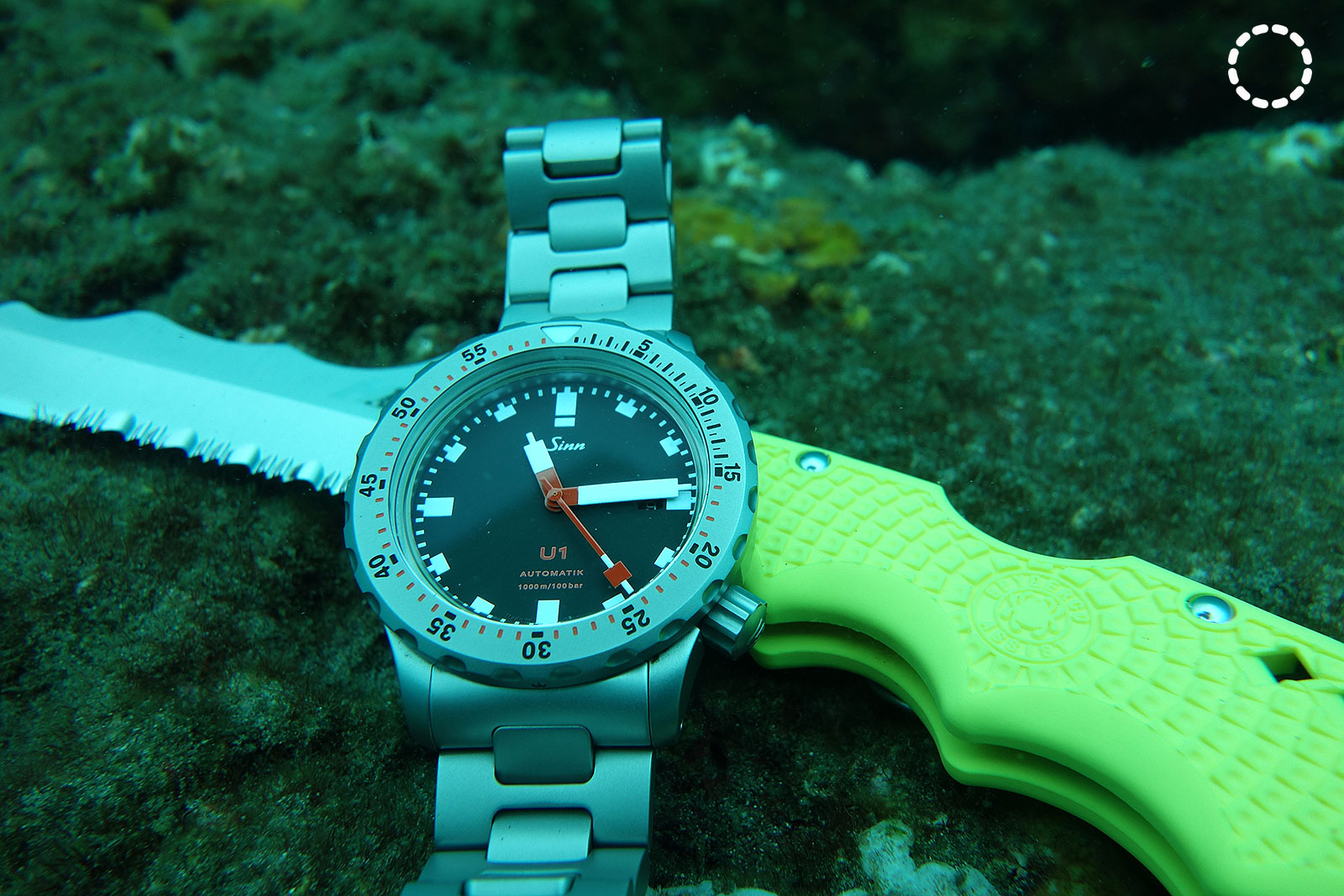
The verdict
The watch I wear most is the Submariner and for several reasons.
To start with 40mm good size, at 30m deep or at 30,000ft in an Airbus A380. The other watches are all significantly larger.
The Triplock-peace-of-mind-crown that assures waterproofness.
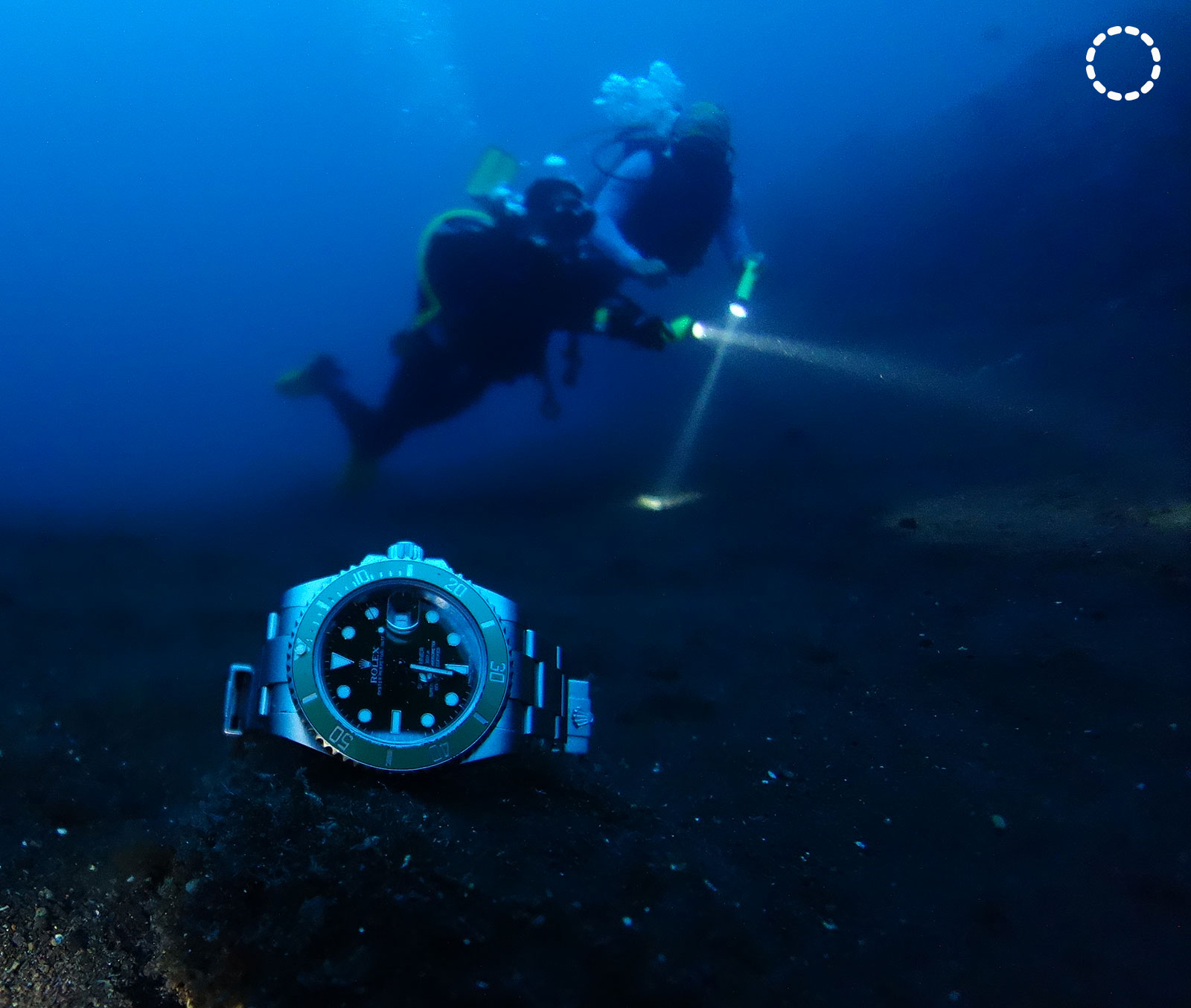
Adjustability on the fly for any wetsuit setup, thanks to the Glidelock clasp, made even better if combined with the wet suit extension from the Deepsea Sea-Dweller.
The Submariner also stands up to abuse, though the case finish as not as hard-wearing as the Sinn U1. Although most watch manufacturers advise you to rinse your watch after a dive in reality the Submariner here never really needed rinsing off after a dive because of the 904L steel used in construction, to date there is no sign of corrosion on the case or bracelet and the ceramic bezel still looks brand new.
But if I could build a fantasy dive watch from scratch; it would be a 42mm Submariner-like with a more robust captive bezel retention design (keep the ceramic tho!), Triplock crown sealing, cased in Tegiment-treated submarine steel, with bright yellow hands and markers on a black dial, tipped with longer lasting Lumi Brite from Seiko. Don’t forget to add the wetsuit extender with extended 26mm travel Glidelock claps (from the Deepsea Sea-Dweller). That would definetly take the cake!
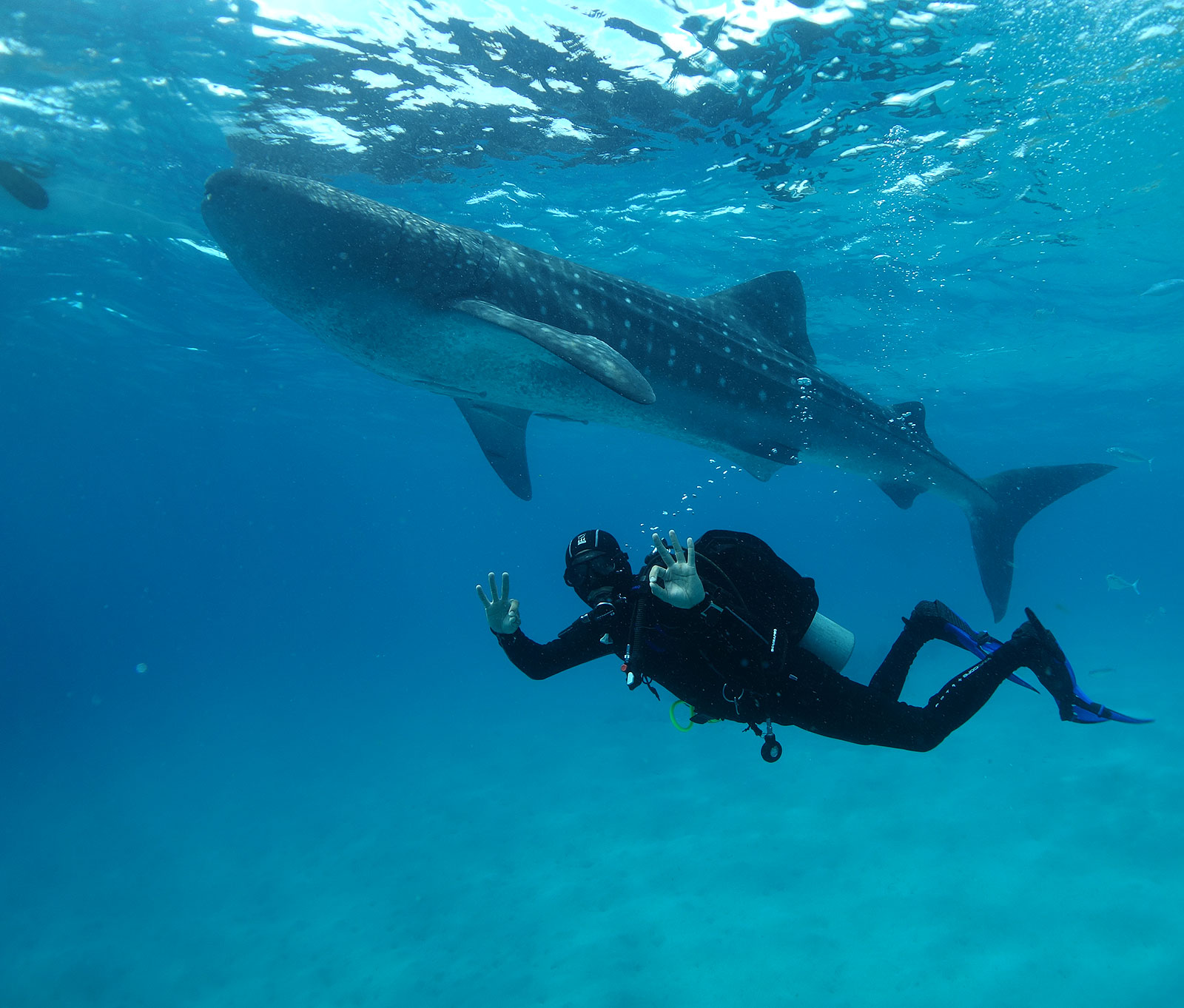
Correction April 3, 2017: The 4R36 movement runs at 21,600bph, not 28,800bph as stated previously.
Dr Wong Ju Ming is a Singapore-based medical professional and a PADI Master Scuba Diver. He has been a watch collector since 2003.
Back to top.
